The world's surprising bucket list dishes you probably won't have tried
Surprising dishes around the world
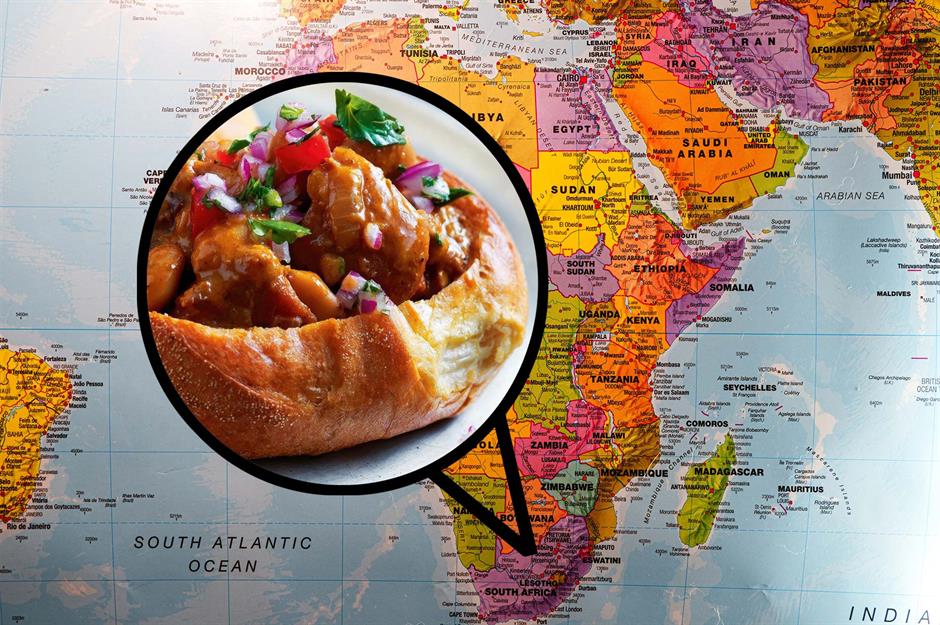
Some dishes are so iconic, people will journey halfway across the globe to try them. But what about lesser-known delicacies? Travelling gives us the opportunity to try all kinds of surprising foods that might seem unusual at first, but are actually delicious. From Australia’s hearty pie floater to Hong Kong’s golden bubble waffles, here we count down to reveal the world's most unusual must-try dishes.
Click or scroll through our gallery to discover 54 unusual bucket-list dishes from around the world, counting down to the one everyone should try.
We've based our ranking on the enduring popularity of each dish in its place of origin and beyond, and on the opinions of our well-travelled (and well-fed) team. The list is unavoidably subjective.
54. Smörgåstårta, Sweden
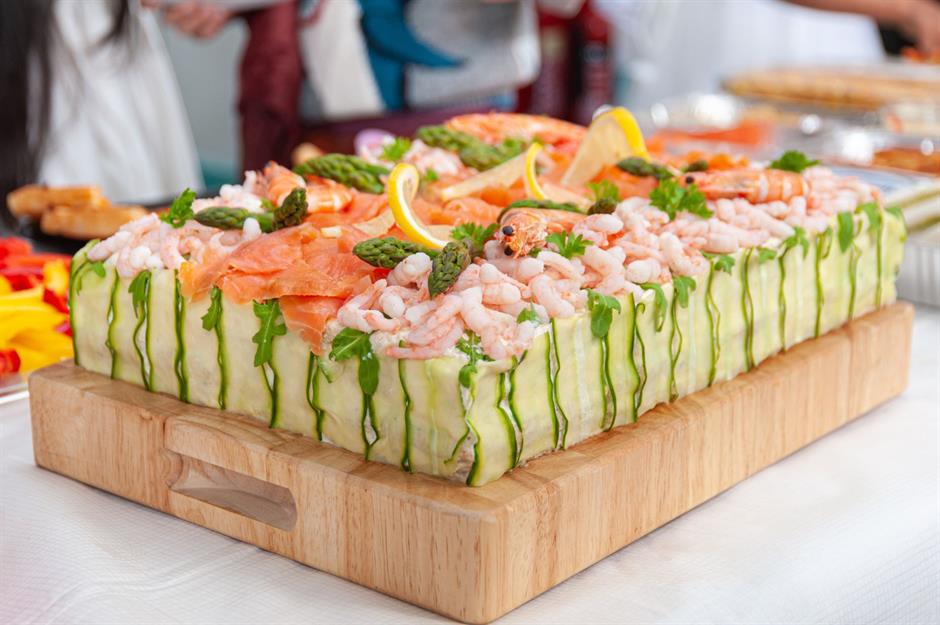
This delightfully kitsch creation was a dinner party favourite in 1970s Sweden and is still a popular sharing dish at parties and celebrations. Smörgåstårta (Swedish sandwich cake) consists of slices of bread layered with all manner of fillings, from smoked salmon and prawns to egg mayonnaise and liver pâté. The whole thing is then iced as you would a sweet cream cake, but using a savoury mixture of whipped cream cheese, mayonnaise and sour cream instead. If you don’t go too overboard with the fillings, it can be utterly delicious.
53. Arepas, Colombia and Venezuela
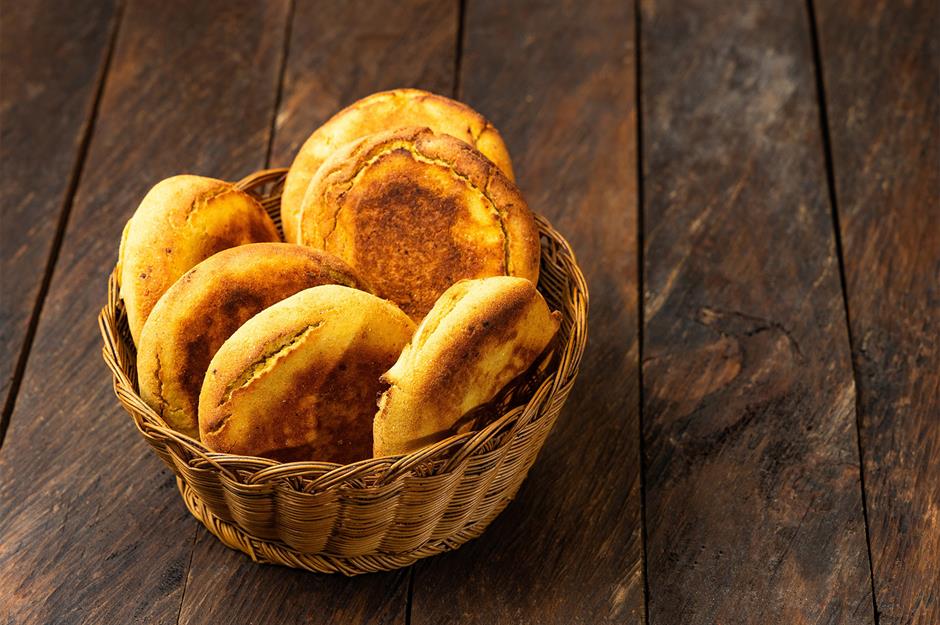
A popular street food, arepas are cornmeal flatbreads filled with all kinds of wonderful flavours. Cooked on a griddle or deep fried, they can be stuffed with meat, beans, cheese or egg. As well as being filled, they’re often topped with ingredients, like an English muffin or flatbread. In Colombia, they’re popular for breakfast or an afternoon snack, served with the spicy pepper sauce ají; meanwhile, in Venezuela, no one’s picky about the right time of day for arepas.
52. Fideuà, Spain
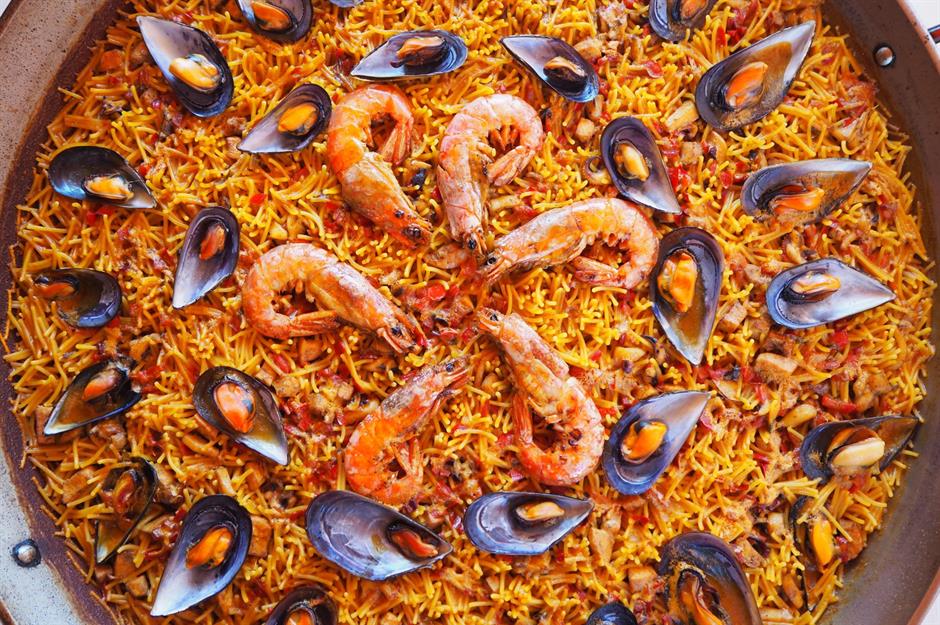
Although it hails from Valencia, fideuà is often thought of as a Catalan dish because of its popularity in the region. Not unlike paella (it’s made in the same sort of flat pan), fideuà consists of a moreish assortment of seafood and vegetables, all cooked up in a shellfish stock along with short pasta noodles called fideos. If you can get your hands on fideos – they're often found in continental delicatessens – this is a surprisingly simple one-pot dish to make at home.
51. Dragon’s beard candy, China
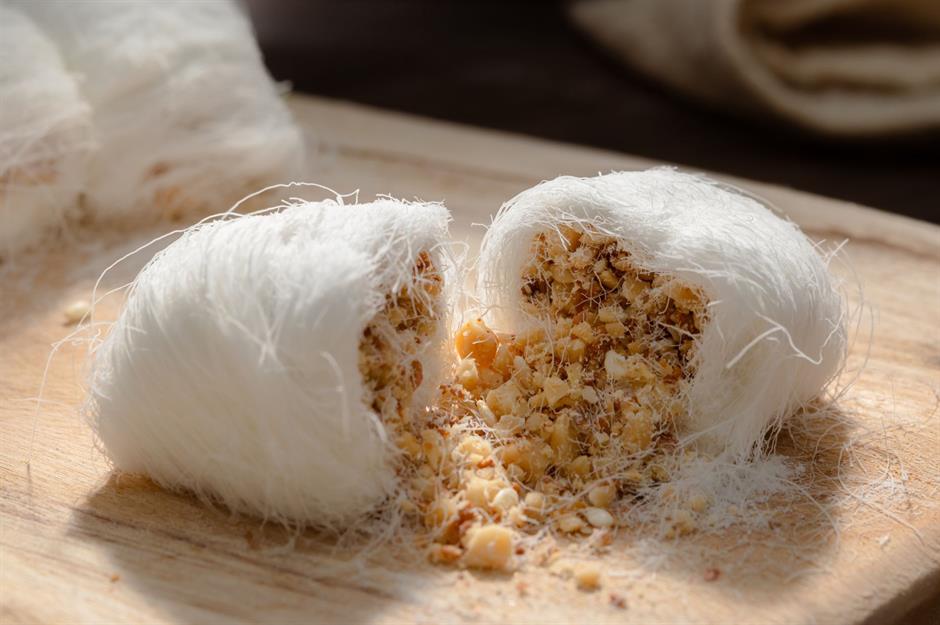
Dragon’s beard candies are stringy cotton candy sweets stuffed with a crushed peanut, chocolate or coconut filling. The production of this sublime confection is a real art form, involving stretching a dough-like mixture made from rice flour into small, thin strands, then delicately wrapping them around a filling. You can watch the treat being made fresh at food markets all over the country, and the intricate process usually draws a crowd. According to legend, the candy was invented during the Chinese Han dynasty over 2,000 years ago.
50. Moreton Bay bugs, Australia
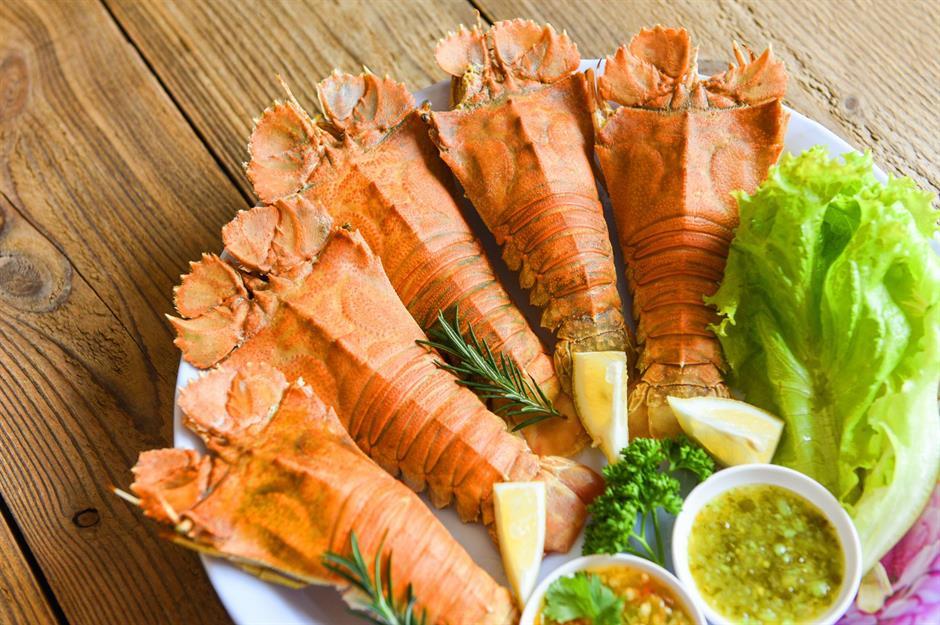
These creatures look more like something from outer space than the sea, but they’re actually something a bit more familiar – flathead (or bay) lobsters. In Australia, they’re commonly known as Moreton Bay bugs and are named after a bay in Queensland. They have a stronger taste than other varieties of lobster and are a mainstay of menus in Sydney’s eateries, where they're usually served with lemon and garlic butter.
49. Papa a la Huancaína, Peru
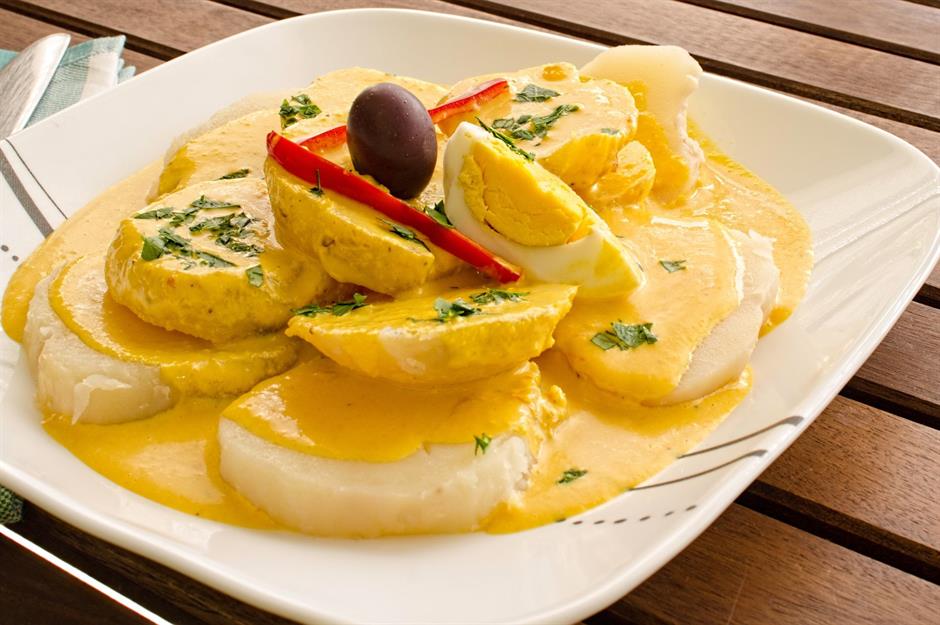
This traditional Peruvian potato dish is a cheese lover’s dream. Papa a la Huancaína (literally translated as Huancayo-style potatoes) consists of boiled potatoes smothered in a spicy, creamy sauce. This unique topping is made by pounding fresh white cheese, yellow Peruvian peppers, red onion and garlic together until thick and smooth. The dish is served cold as a side dish in restaurants all over Peru and usually comes garnished with parsley, olives and sliced hard-boiled eggs.
48. Gulab jamun, India
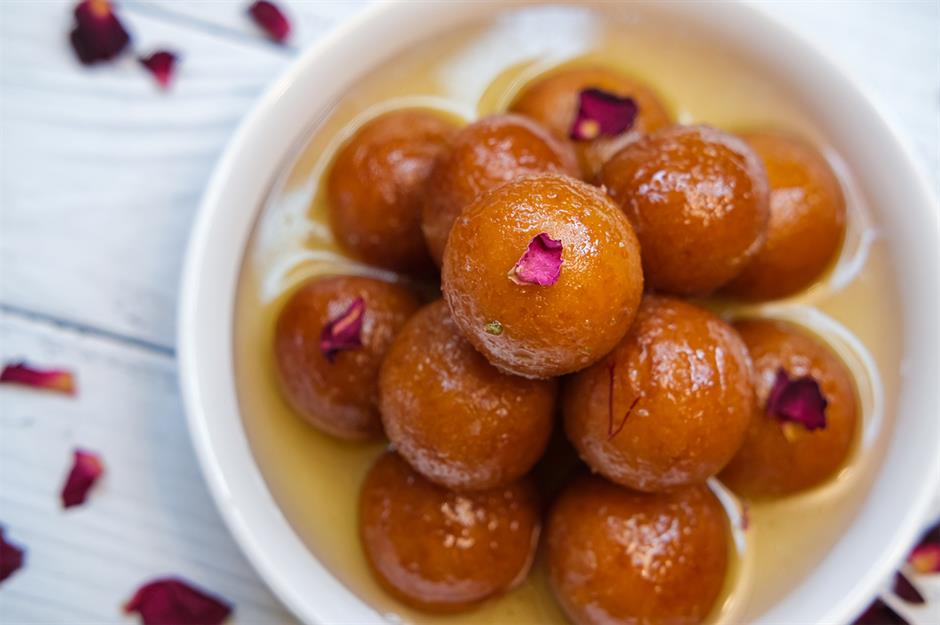
Sticky, spiced gulab jamun is a favoured dessert in India, Pakistan, Bangladesh, Nepal and Myanmar. These fried dough balls are made by soaking milk solids (in modern recipes, powdered milk is often used) in a fragrant sugar syrup flavoured with ingredients such as cardamom, rose and saffron. Gulab jamun is popular at festivals and celebrations, in a variety of different sizes, and with all sorts of different fillings, colours and toppings.
47. Frickles, USA
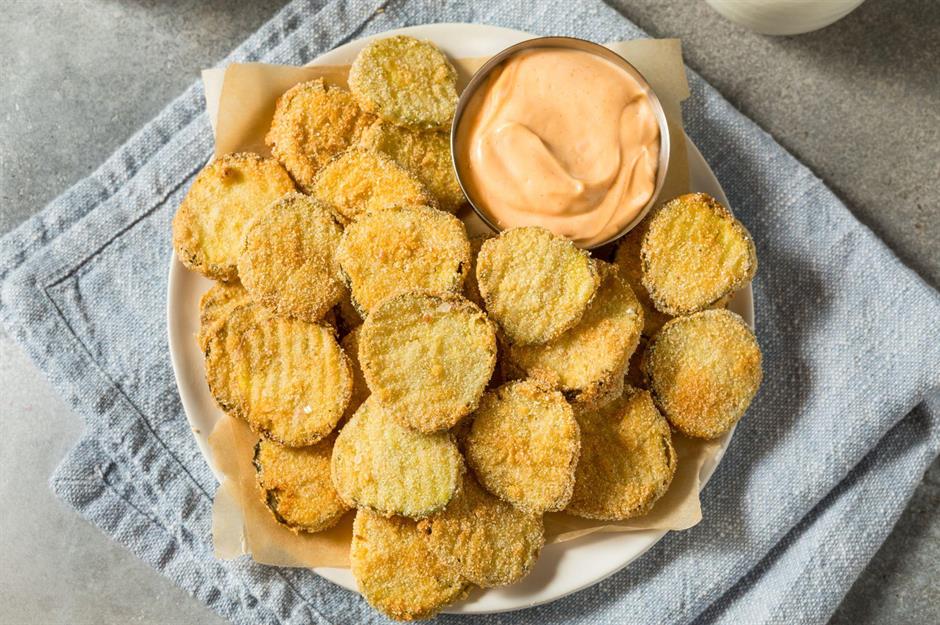
Fried pickles, or frickles, are a classic and much-loved bar snack in the Southern United States – particularly in Arkansas, where they were supposedly invented in the 1960s. To make them, salty, snappy dill pickles are sliced, battered and fried to crispy perfection, and they're served with ranch dressing or another creamy sauce for dipping. This deep-fried delicacy isn’t for everyone, but we (along with many others) think it’s ingenious and pretty addictive. Recently, frickles have become a popular dish in trendy pubs and cafés in the UK, Australia and New Zealand.
46. Truffade, France
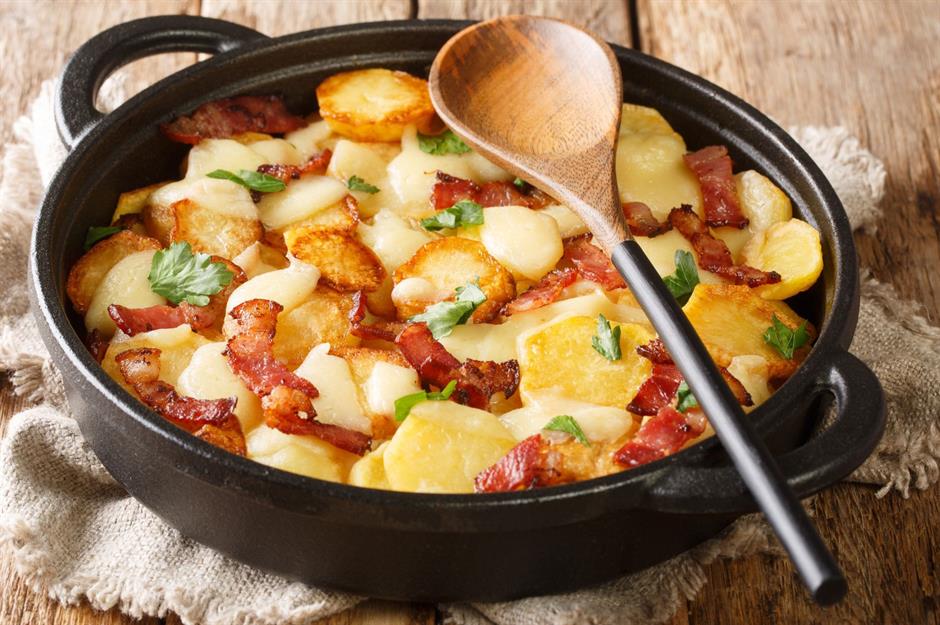
This iconic mountain dish originated in the Auvergne region of France and is one of the country’s most mouthwatering comfort foods. The ingredients might be simple – just cheese, bacon, garlic and potato – but this rustic pancake is so much more than the sum of its parts. To make a classic truffade, thinly sliced potatoes are slowly cooked in lard or goose fat until tender, then mixed with strips of tome fraîche (a type of hard-pressed cheese curd that’s slightly fermented) until rich and gooey. Extra ingredients like garlic, crispy bacon lardons and fresh parsley are often added, too.
45. Koulouri, Greece
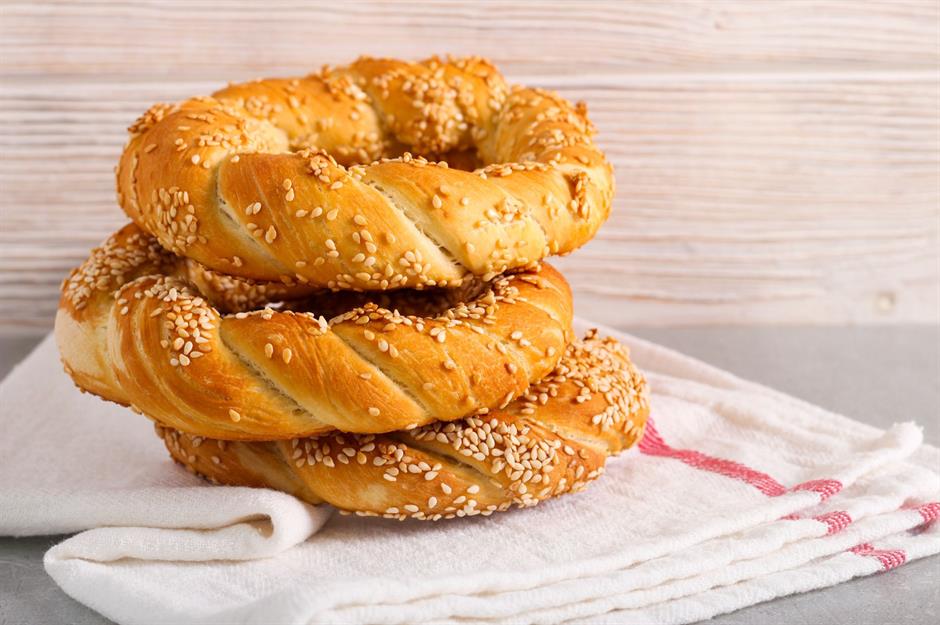
If you’ve ever visited a proper Greek bakery, you’ll know that Greek cooks have a way with bread. One of the tastiest bakes to look out for is koulouri, a circular bread covered in sesame seeds (or occasionally poppy seeds). It's light and a little sweet, with a crunchy crust and a wonderfully soft, slightly chewy centre. Sold out of carts on street corners, it’s traditionally enjoyed for breakfast with a cup of coffee.
44. Sarde in saor, Italy
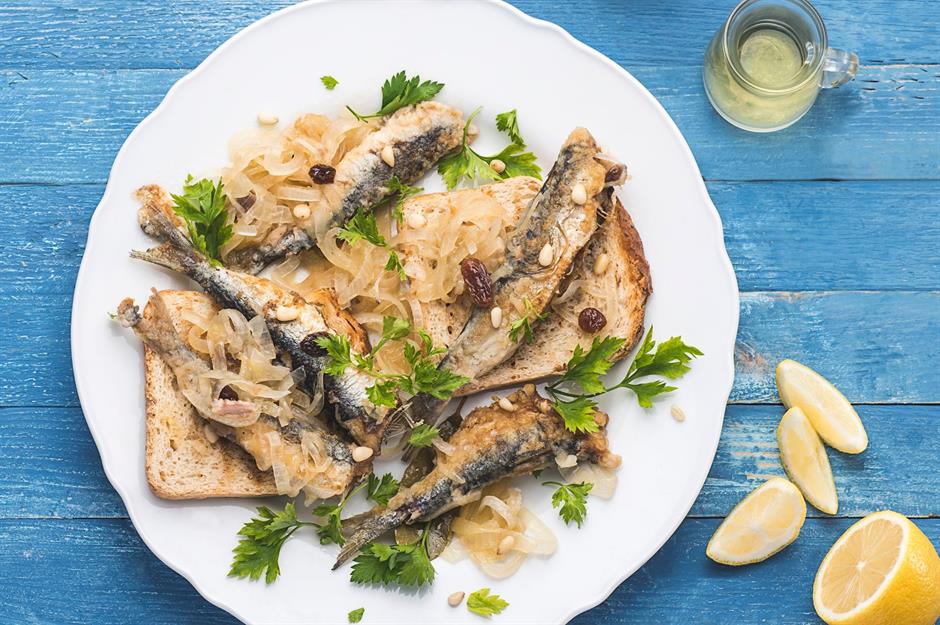
Sarde in saor is a simple dish typical of cicchetti, bitesized titbits similar to pintxos or tapas, which are found in Venetian bars. It’s certainly not to be ignored – the freshest sardines are deep fried and left to marinate in a slightly sweet, slightly vinegary sauce along with thin slices of prized Chioggia onions. This process both flavours and preserves the dish. Before serving, the sardines are sprinkled with pine nuts and sometimes raisins, making for an admittedly unusual but very tasty dish.
43. Poutine, Canada
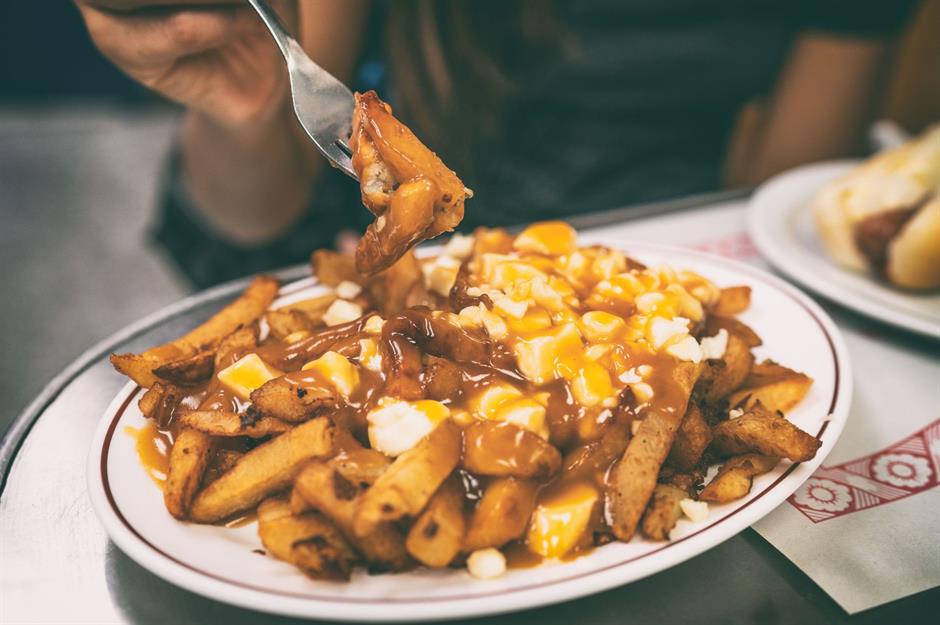
Chips, cheese curds and gravy. What’s not to love? This Quebec-born fast food dish emerged in the late 1950s and has since become Canada’s unofficial national dish. You can grab a delicious serving of poutine at upscale restaurants and dive bars alike, and it’s so prevalent that even Canadian branches of McDonald’s sell it. Canadians will argue that there’s no comfort food quite like poutine – and they’re probably right.
42. Currywurst, Germany
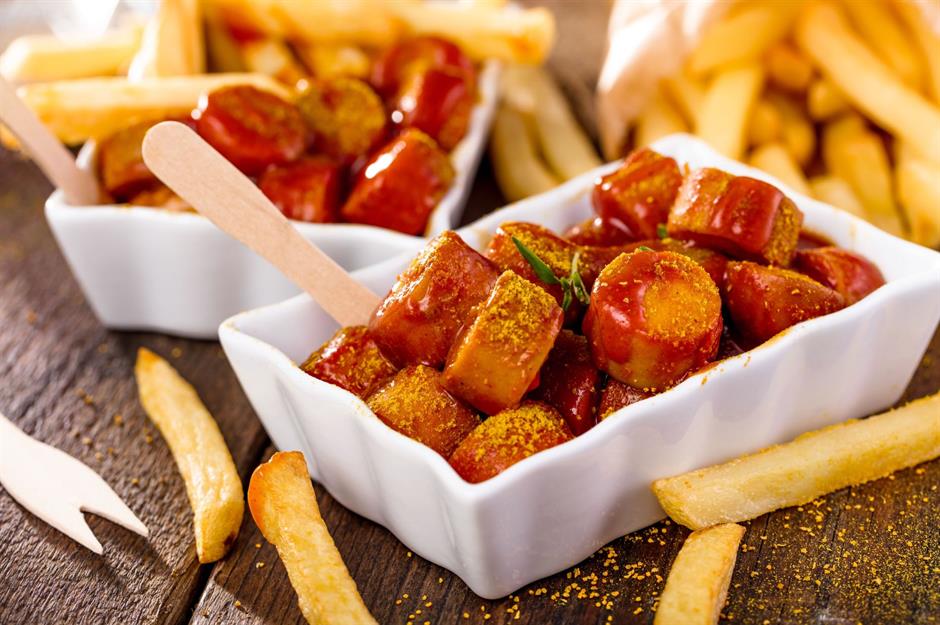
Born in Berlin – and now loved throughout Germany (and beyond), currywurst is a meaty street food smothered in a piquant sauce. To make it, a pork sausage is steamed, fried until crispy, then covered with tangy curry ketchup (and often sprinkled with more curry powder). To complete the meal, French fries or a bread roll are served on the side. Head to one of Berlin’s numerous currywurst stalls to experience this comfort food at its finest.
41. Khachapuri, Georgia
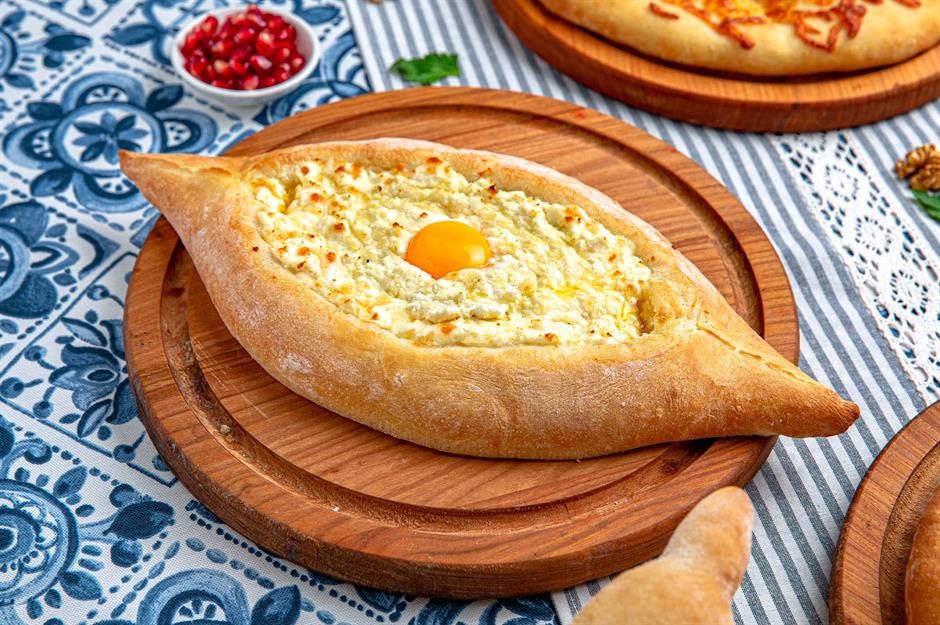
This boat-shaped flatbread is typically filled with salty, stretchy cheese and a whole egg. It’s often compared to a pizza, but it has its own textures and flavours that make it distinct – and depending on where you go, it can be stuffed with meat, cheese or even a spinach and potato purée. Another key ingredient, according to khachapuri fans, is the happiness of the baker; they say if the cook is in a good mood, it shows in the final product, and it’s guaranteed to make the person who eats it happy, too.
40. Cold eel noodles, China
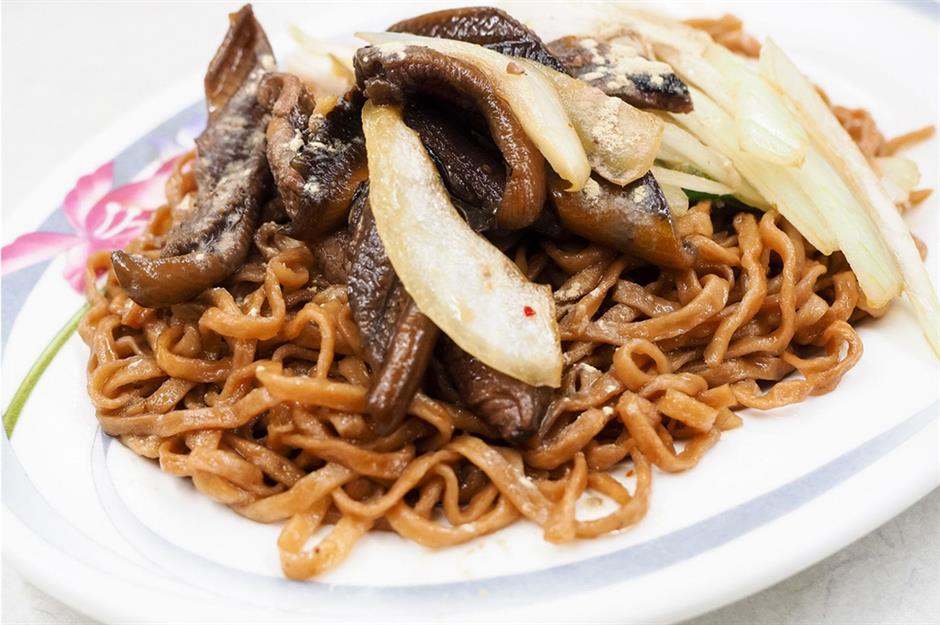
Shanghai is a street food hub, and knowing what to try first here is a battle between head and stomach. However, since China’s largest city is known for its eel dishes, it surely has to be shansi leng mian: cold flat noodles served with hot eel in a savoury, umami-rich sauce. The tantalising differences in temperature, texture and flavour make this dish one to hunt down.
39. French dip sandwich, USA
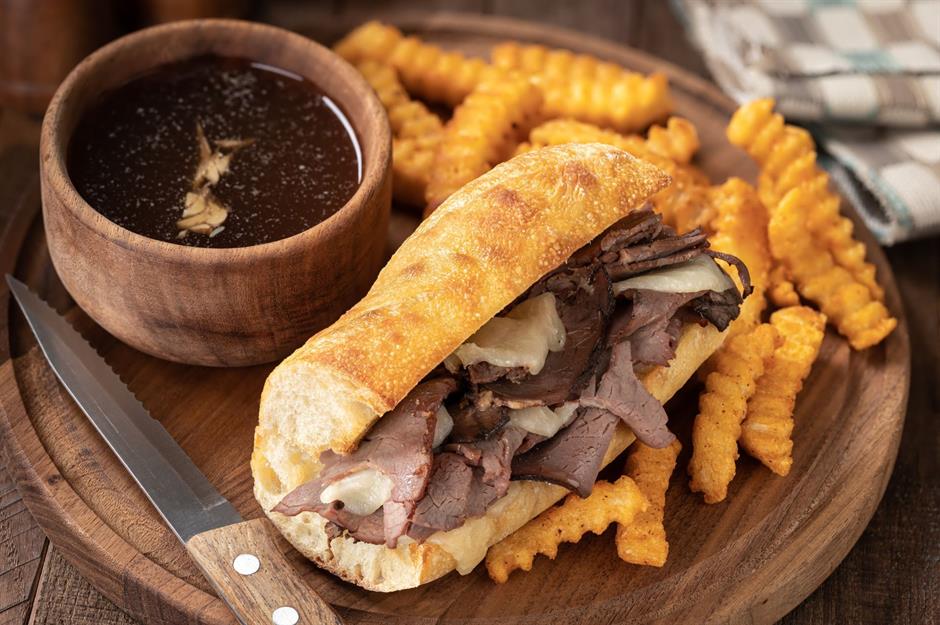
The only thing French about this sandwich is the bread it's served on. This utterly divine dish was invented in Los Angeles, California in the early 20th century at one of two historic restaurants – either Phillipe's or Cole's, depending on who you ask – and it consists of thinly sliced roast beef, melted Swiss cheese and onions, all stuffed into a baguette. The most crucial element is the dip: some restaurants offer a bowl of jus (a thin gravy) on the side to dip it into, while others will dredge the entire sandwich in the delicious cooking juices.
38. Jellied eels, UK
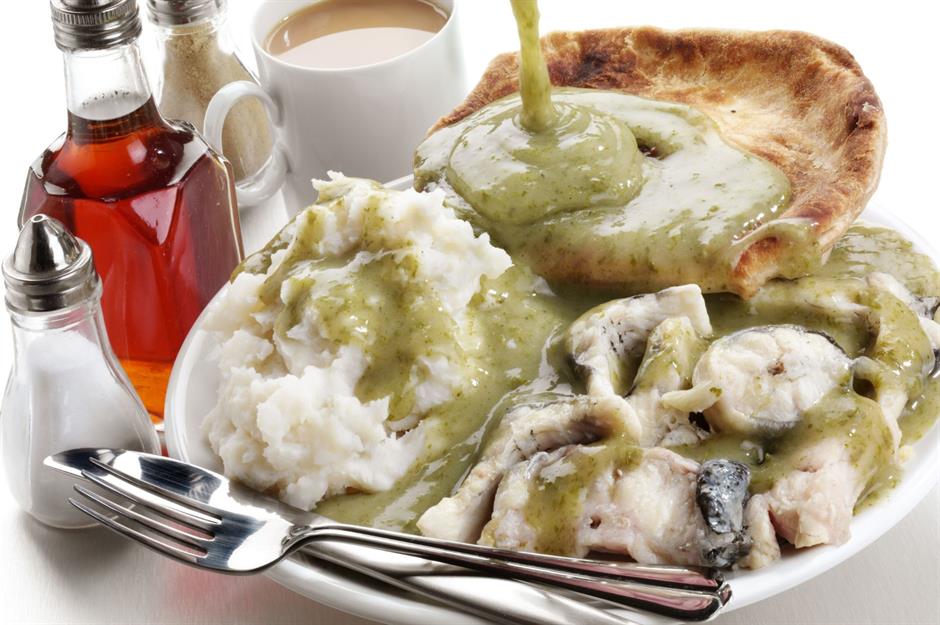
For a truly old-school Great British food experience, jellied eels are a must-try. Traditionally sold at pie and mash shops, they were a popular and affordable dish in 18th-century London, when there was an abundance of eels in the River Thames. To make them, chopped eels are boiled in a spiced stock that cools to form a set jelly. They’re certainly an acquired taste, but they're a cult favourite in the city’s remaining pie shops.
37. Käsekrainer, Austria
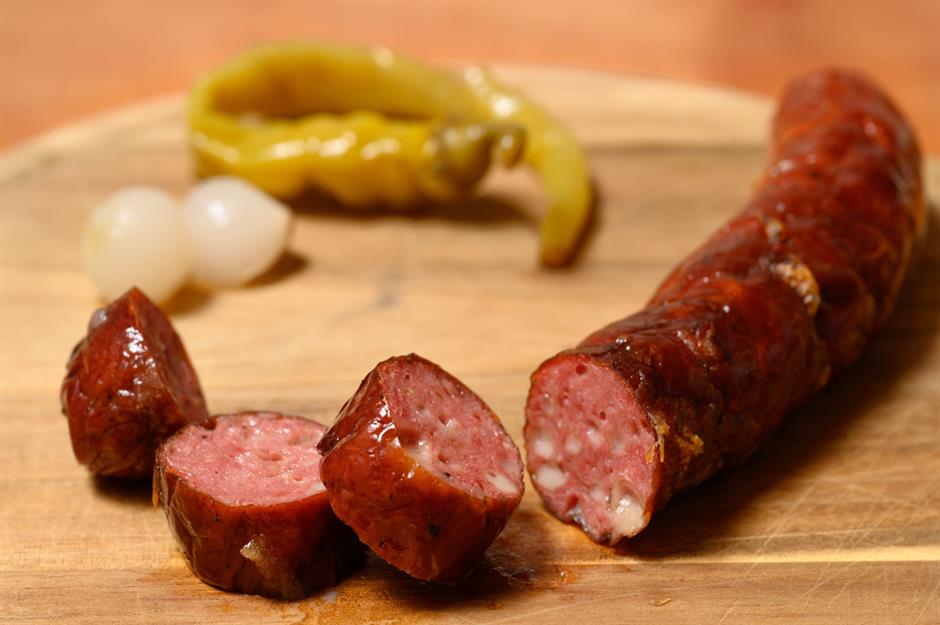
It’s no surprise that sausages are big in Austria, but the country has a long-time love affair with käsekrainer that shows no sign of waning. A variety of Carniolan sausage from Slovenia, the käsekrainer harbours a tasty secret. Usually served from street stands, it looks and tastes like a hot dog sausage, until the first bite releases oozing melted cheese. When dipped in hot mustard, it's nothing short of sensational.
36. Farinata, Italy
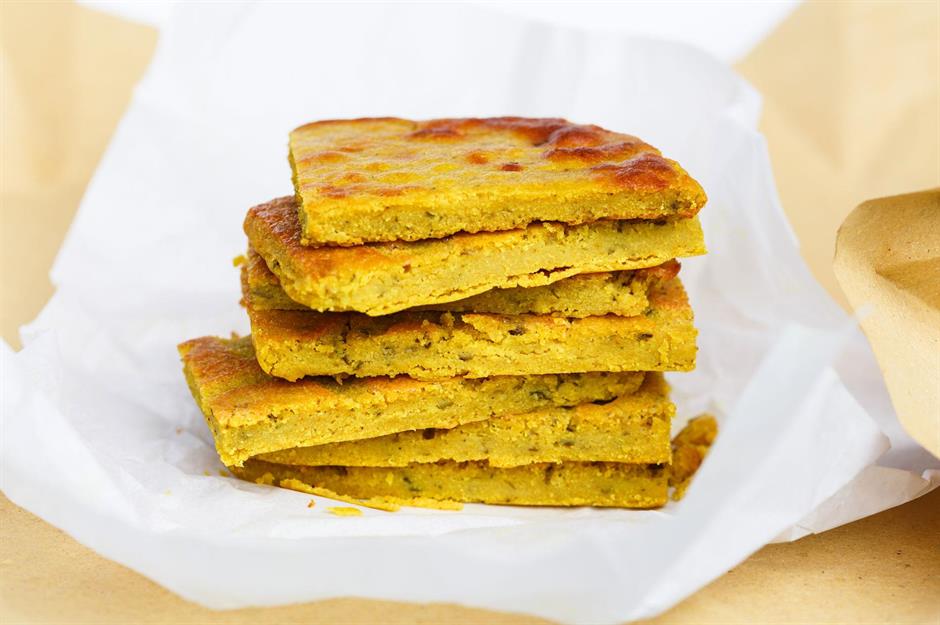
This simple chickpea pancake from Liguria may not look like anything special, but farinata has been embraced across Italy (primarily because it’s absolutely delicious). Traditionally made with nutritious chickpea flour and cooked in a wood-burning oven to ensure a crisp, golden crust and a fluffy, chewy centre, it's usually served with seasonal vegetables and dips – or with toppings, in the style of a rustic pizza.
35. Hangi, New Zealand
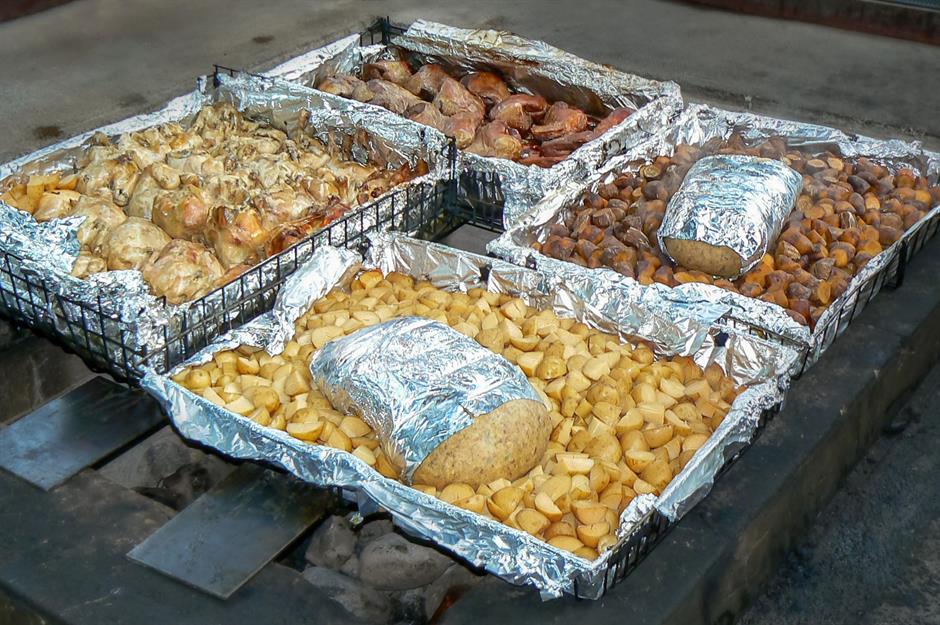
For an indigenous experience like no other, Māori cuisine has to be sampled. Hangi is a traditional method that sees fish or meat such as chicken thighs, mutton and pork cooked alongside root vegetables (carrots, kumara, potatoes and pumpkin) on heated rocks that are buried in an underground pit oven called an umu. The result? Smoky, succulent slow-cooked meat and vegetables. The entire hangi experience is really something special.
34. Käsespätzle, Germany
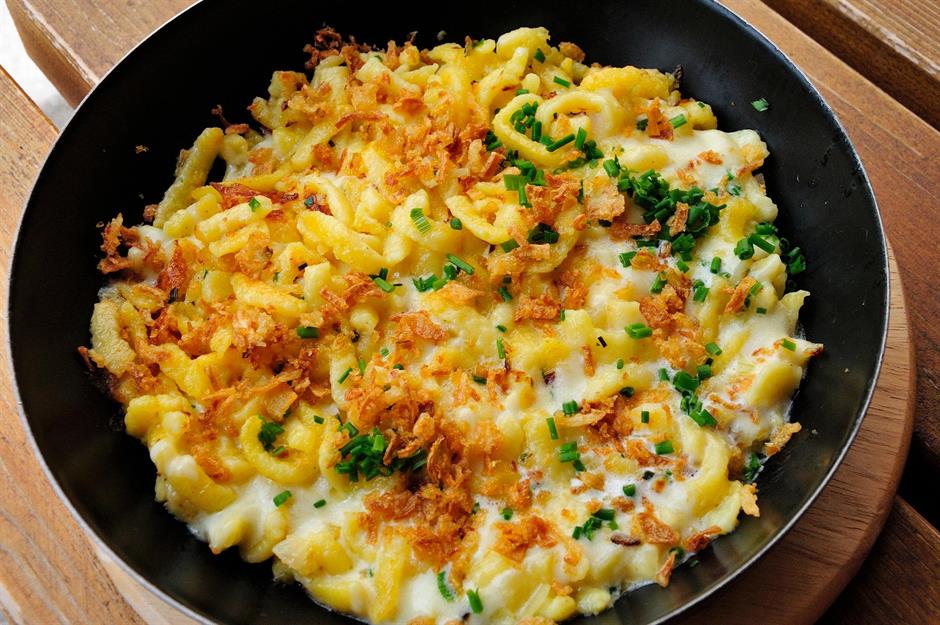
Spätzle are made by passing a loose dough through a piece of equipment similar to a colander; as the dough falls through the small holes, it drops into boiling water to become firm, slightly chewy dumplings, a bit like pasta. To make traditional käsespätzle – a dish enjoyed in some regions of Germany, Austria, Switzerland and Liechtenstein – onion, eggs, milk and cheese (such as Gruyère) are added, and the whole thing is baked. The comfortingly melty delicacy is often served with salad or apple sauce.
33. Pintxos, Spain
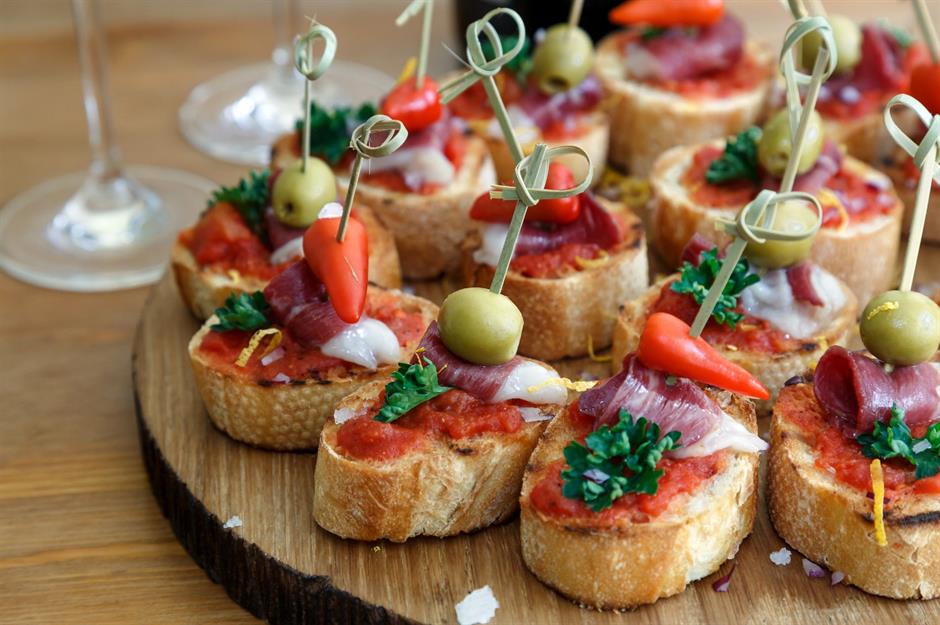
Although pintxos (pinchos) can be found across Spain nowadays, these bitesized morsels originated in the Basque Country, the home of foodie paradise San Sebastián. A variety of toppings are skewered onto small pieces of bread with toothpicks, and they're served in pintxos bars and taverns. A true taste of northern Spain, there’s a topping for everyone, from tortilla to octopus and jamón.
32. Babbouche, Morocco

We tend to associate eating snails with France or Spain, but they’ve been devoured as a street food in Morocco’s capital city, Rabat, for decades. Known as babbouche or b’bouch, this high-protein, low-fat snack is slowly stewed in an aromatic broth seasoned with the likes of cumin, ginger, liquorice root and thyme. Vendors cook the snails in huge vats at the city’s many food markets, and a toothpick is the tool of choice for prising the tasty creatures from their shells.
31. Suppli, Italy
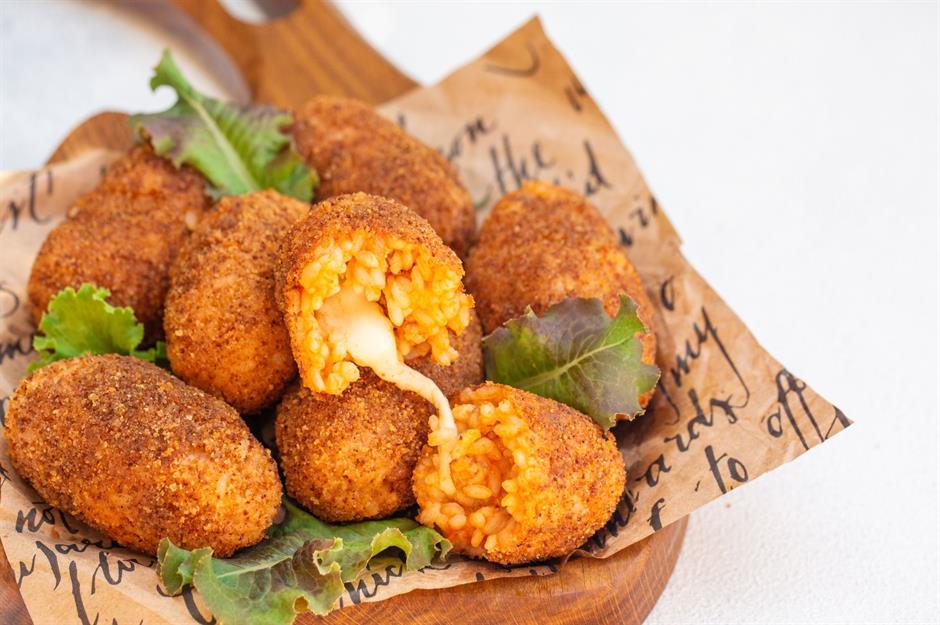
Rome is awash with delicious specialities to hunt down, but foodies in the know head straight for the suppli. These handheld snacks are native to Rome, and they're regarded as a local favourite. A cross between arancini and croquettes, suppli are made from risotto rice, tomato sauce and mozzarella; they're rolled in egg and breadcrumbs, then fried until shatteringly crisp. Though they used to be available from street vendors around the city, these days you’re more likely to see them as a starter in restaurants.
30. Bhel puri, India
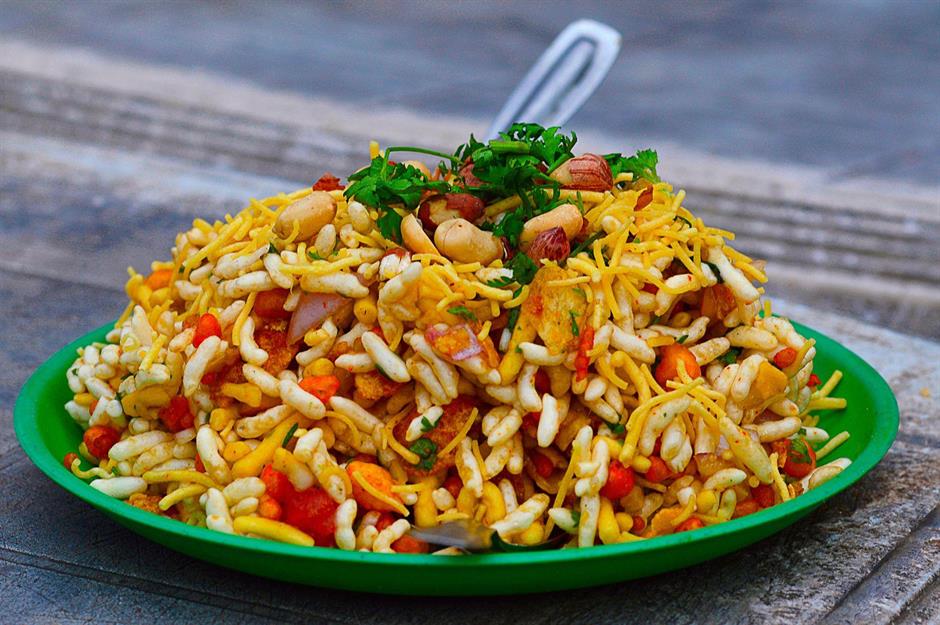
This sweet-and-sour snack of puffed rice, chopped onion, sev (crunchy chickpea noodles) and potato and tamarind chutney is so important to Mumbai's culinary heritage that The Bombay Times runs an annual contest to find the King of Bhel. Technically a type of chaat, bhel puri is a wildly popular street food snack that’s available from stands across the city and beyond, though it’s also easy to make at home.
29. Laverbread, UK
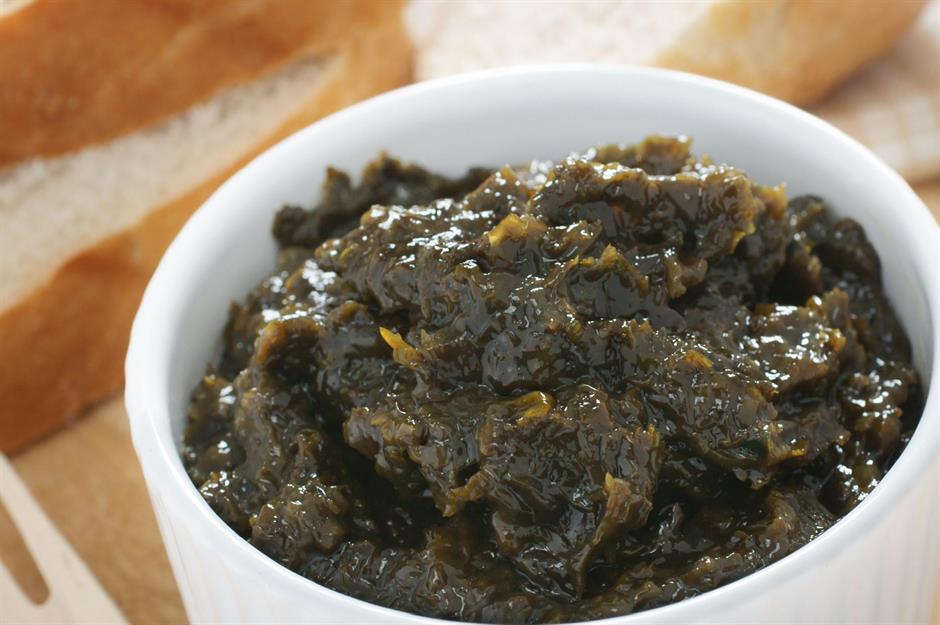
Don’t be fooled by the deceptive name – this Welsh favourite doesn’t actually contain any bread. A dark green paste made from boiled seaweed, laverbread inspires Marmite-like levels of love and hate, thanks to its distinctive taste and texture. Dubbed ‘Welshman’s caviar’, laverbread has been enjoyed since the 17th century, and it's traditionally served with bacon and cockles as an essential part of a Welsh breakfast. These days, it’s having a bit of a renaissance in Wales, with artisan producers using it to make everything from bread to oatcakes.
28. Sugar on snow, Canada
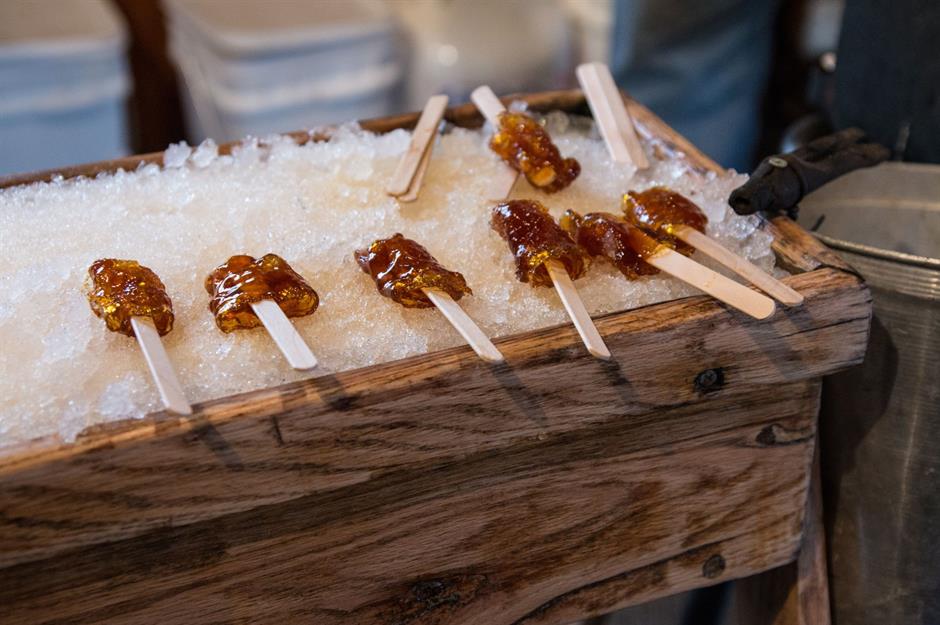
Canada is the world’s biggest producer of maple syrup, so it comes as no surprise that one of the country’s tastiest offerings is maple based. Also called maple taffy (tire d'érable in French), this flavoursome candy is a delight to the eyes and the taste buds. It's made by boiling maple sap to around 112°C (234°F), then pouring the hot liquid onto virgin snow; it reacts with the cold and hardens. It can be wrapped around sticks or simply plucked from the snow.
27. Horumonyaki, Japan

When in Rome, do as the Romans do. And when in Japan, do as the Japanese do: eat ‘stamina-building’ horumonyaki – if you’re brave enough, that is. This Osakan speciality was invented in around 1940, and it's an offal lover’s fantasy: pig spleen, stomach, intestine and heart (as well as arteries and rectums for more courageous souls) are all cooked on a charcoal grill, then served with a soy-based tare sauce.
26. Herring under a fur coat, Russia
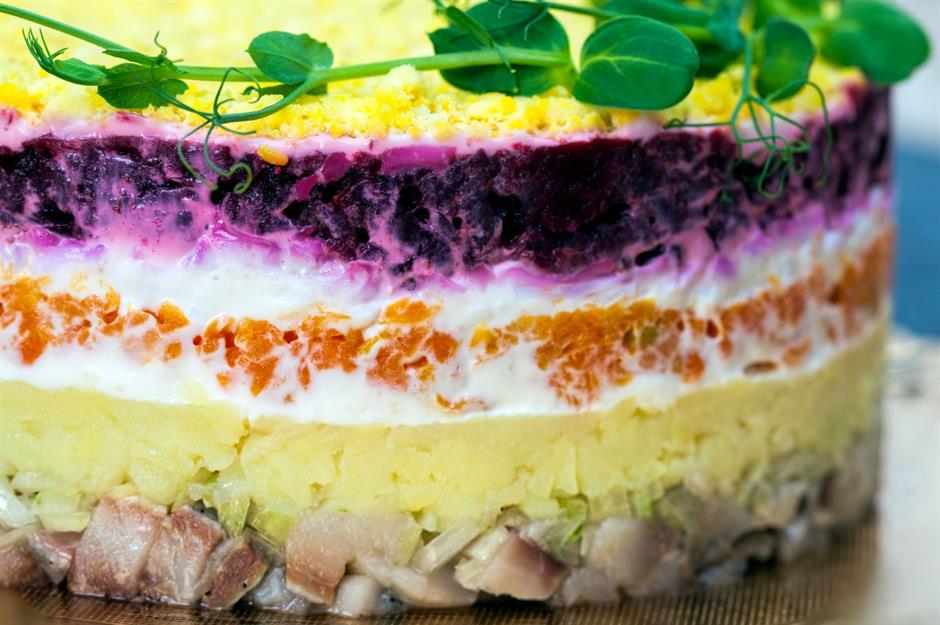
The more prosaic name for this layered salad of pickled herring, onion, boiled vegetables and mayonnaise is dressed herring, but let’s go with the infinitely preferable nickname ‘herring under a fur coat’. It's usually served as a zukuski (Russian canapé or hors d’oeuvre), and a gathering isn’t a gathering without it – especially at Christmas. Restaurants present it in both traditional and more contemporary forms.
25. Escamoles, Mexico
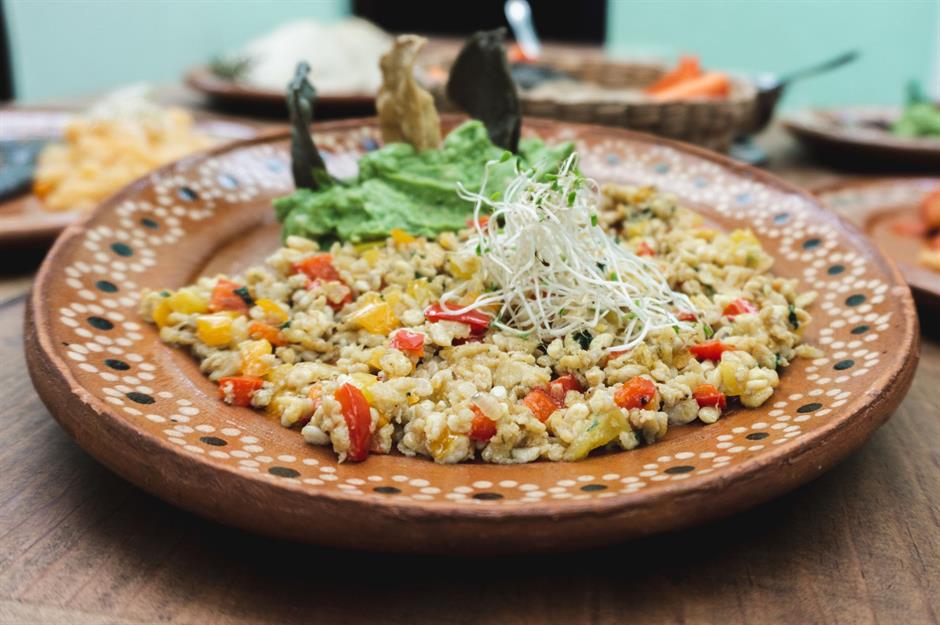
Creamy, nutty escamoles, also known as Mexican caviar (or insect caviar), are an unusual treat made from the edible larvae and pupae of ants. The tasty grubs are usually simply fried in butter with onion and chilli, then served in tacos. Escamoles can be bought from Mexico City’s famous Mercado San Juan de Pugibet, where you’ll also find the likes of ground and spiced chicitana (flying ants) spread on tortillas, and toasted crunchy chapulines (grasshoppers).
24. Romeu e Julieta, Brazil
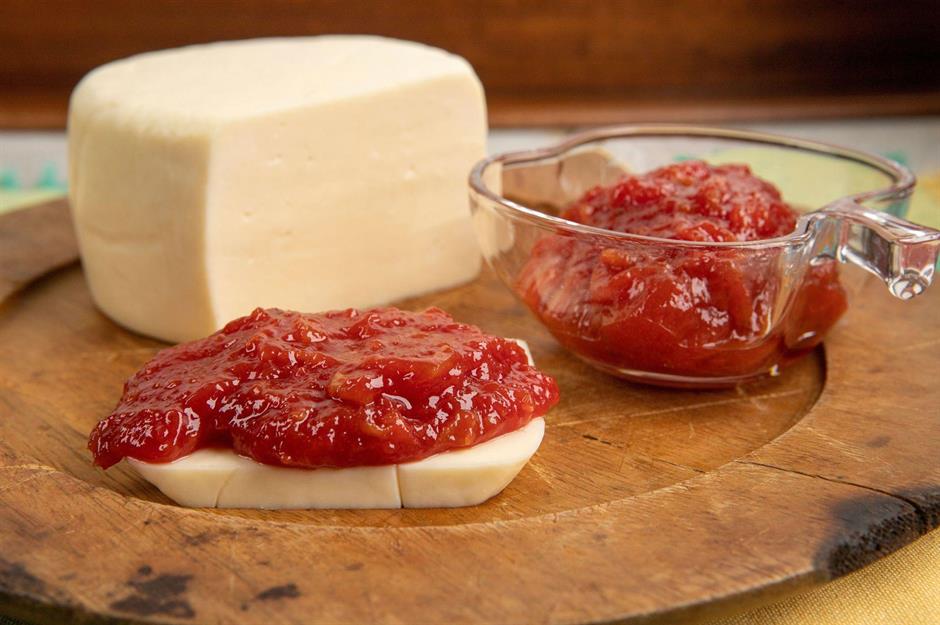
Those with a sweet tooth are spoiled for choice in Brazil, where you can feast on local favourites like brigadeiro, chocolate fudge balls that are considered to be the country’s national dessert. But for something a little different, look out for Romeu e Julieta: a slice of ruby-red guava paste sandwiched between two slices of white Minas cheese. It’s unclear why this unusual sweet was named after the famous Shakespeare play, but Romeu e Julieta is beloved throughout the country. It's commonly served as both a snack and a dessert.
23. Filet Américain, Belgium
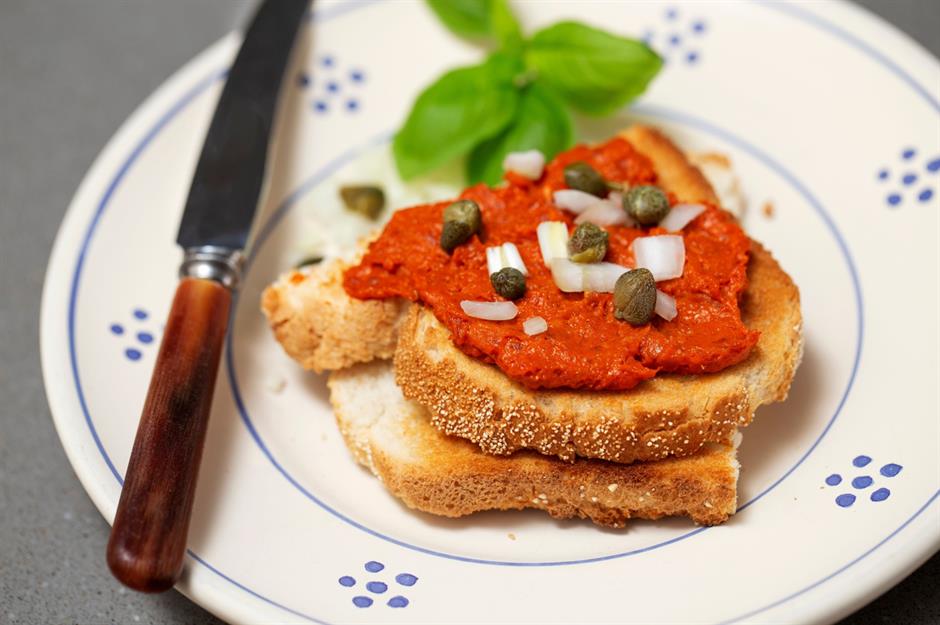
Belgium has given us two world-famous dishes – moules frites and waffles – but the country has numerous other delights to offer foodies. For something a little different, try filet Américain. Sometimes confused on menus with an actual beef steak, it's a smooth paste made by grinding lean premium beef with seasonings like onions, capers, mustard, mayonnaise and Tabasco and Worcestershire sauces. Taste-wise, it’s similar to steak tartare, but with a silkier, smoother texture. It's usually served spread on crusty bread or crackers.
22. Fried insects, Thailand
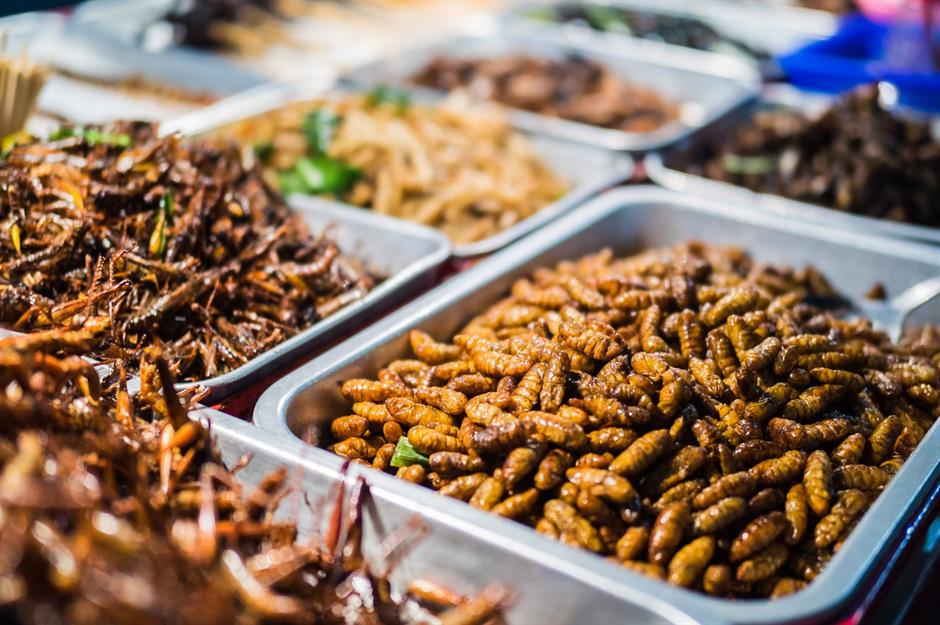
If you consider yourself an adventurous eater and are visiting Thailand, make sure you give fried insects a try. Making regular appearances at Bangkok’s famous food markets, they're not unlike crisps: crunchy, savoury and a little bit greasy. Take your pick from ant queens, bamboo worms, crickets and weevils.
21. Chả cá lã Vọng, Vietnam
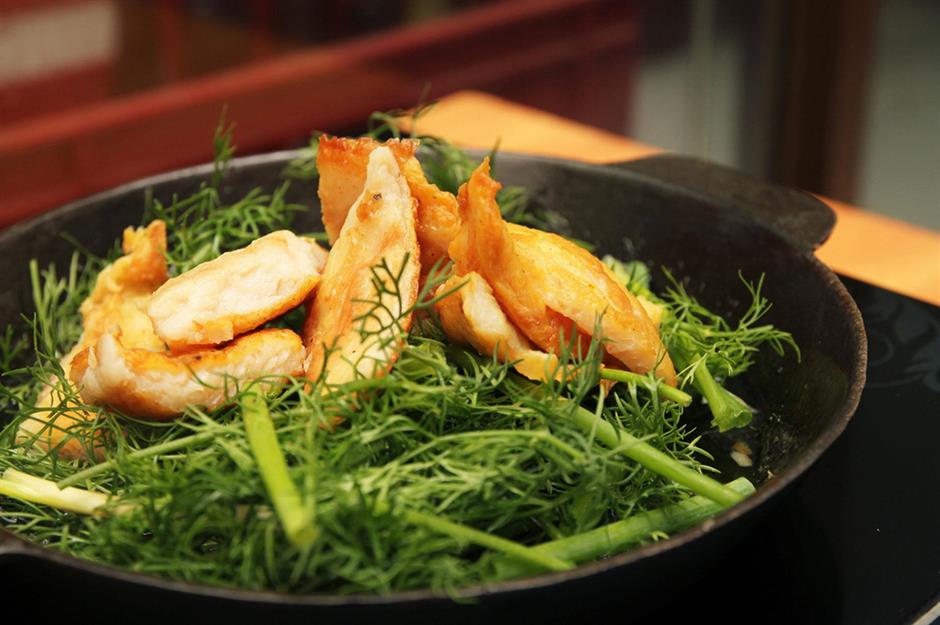
Visitors to Vietnam are spoiled for choice when it comes to food, but in Hanoi there’s a particularly iconic treat that begs to be tried: chả cá lã Vọng. It’s a bright, light and spicy dish of turmeric-fried fish with vermicelli, dill, ginger, galangal, onions and shrimp paste. Peanuts and pineapple sometimes make an appearance, too. This dish was first served at Hanoi’s Cha Ca La Vong restaurant back in 1871; today, the original spot only serves this signature dish, and guests eat it from charcoal burners at communal tables.
20. Pisang goreng, Indonesia
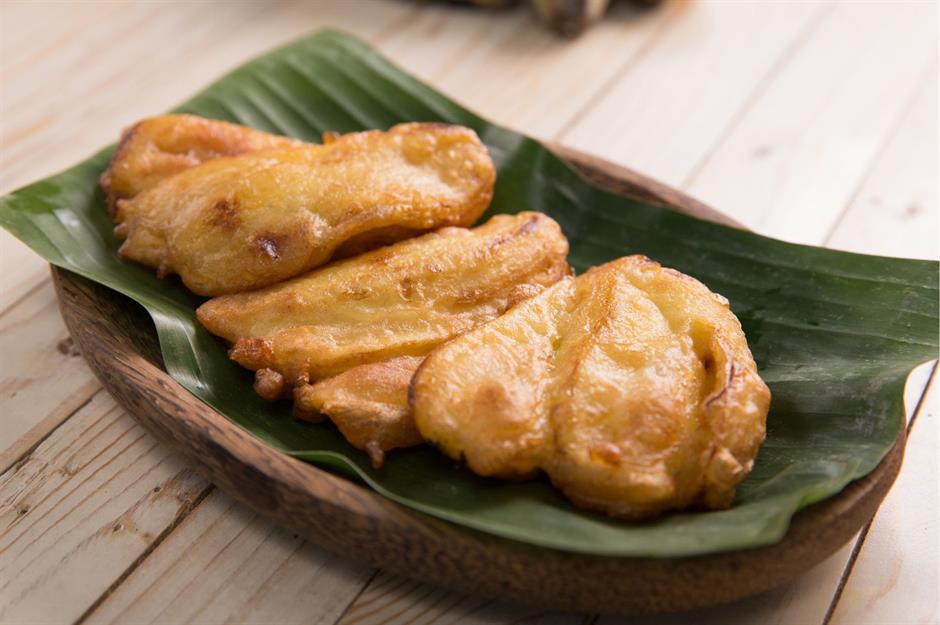
Yes, there’s beef rendang and chicken satay – two delectable Indonesian dishes that most of us will have tried – but for something a bit different, opt for pisang goreng, a delicious street food snack. These banana fritters are sprinkled with cheese or chocolate sauce (or both). They’re simultaneously crunchy, fruity, sweet, creamy and salty, which makes them pretty much irresistible, in our book.
19. Brik, Tunisia
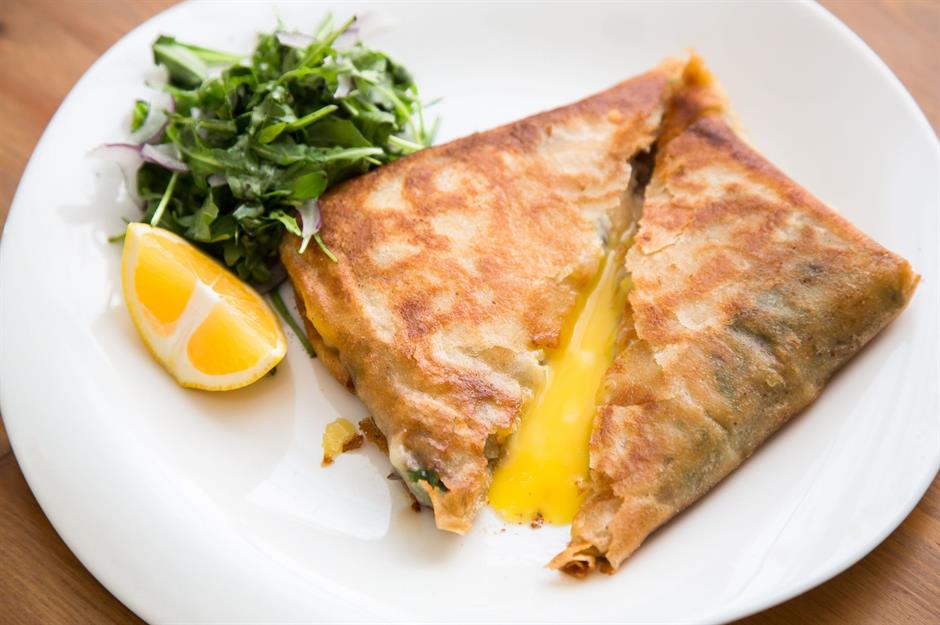
A distant cousin of the Turkish borek, brik (pronounced 'brreek') are triangular-shaped filo pastry snacks stuffed with all kinds of tasty fillings, from mashed potatoes to chicken, tuna, seafood, ground meat and egg. They’re traditionally flavoured with capers, cheese, harissa or onion, so they're absolutely packed with flavour. They’re lighter than they sound, too. A trip to Tunis isn’t complete without a stroll around a souk, where you can sample brik at their best – freshly cooked and still piping hot.
18. Akara, Nigeria
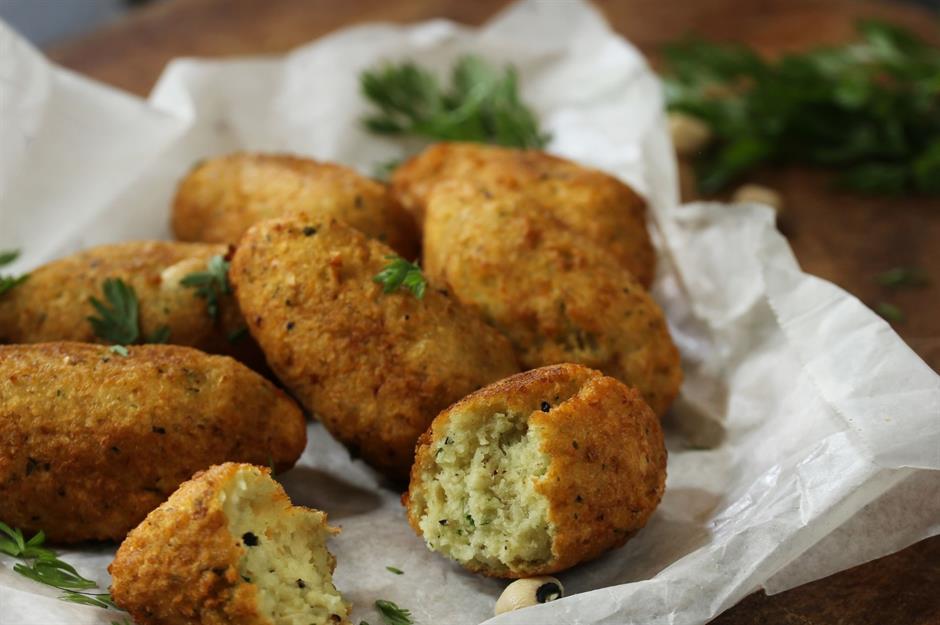
Diverse, aromatic and utterly delicious, Nigerian cuisine is known for its rice and bean dishes and spicy sauces. One street food dish really worth hunting down is a popular bean-based snack called akara – balls made from black-eyed peas and chilli, which are fried in palm oil until golden on the outside and fluffy in the middle. The dish is commonly eaten at breakfast and features prominently in the culture of the Yoruba people. A similar dish, acarajé, exists in Brazil.
17. Bunny chow, South Africa
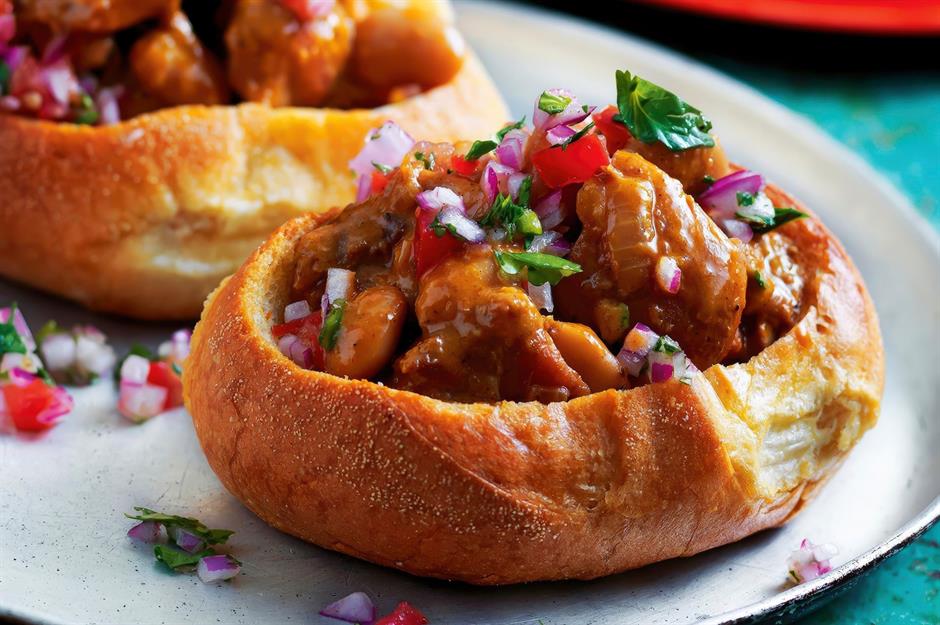
Despite the name, no rabbits are involved in the making of bunny chow. This hefty dish consists of a hollowed-out loaf of bread filled with either meat or vegetable curry, and it's often served with a spicy carrot and onion salad. It’s widely thought that Indian immigrants in Durban created this portable meal in the 1940s – and it’s now a much-loved street food around the country.
16. Spaghettieis, Germany
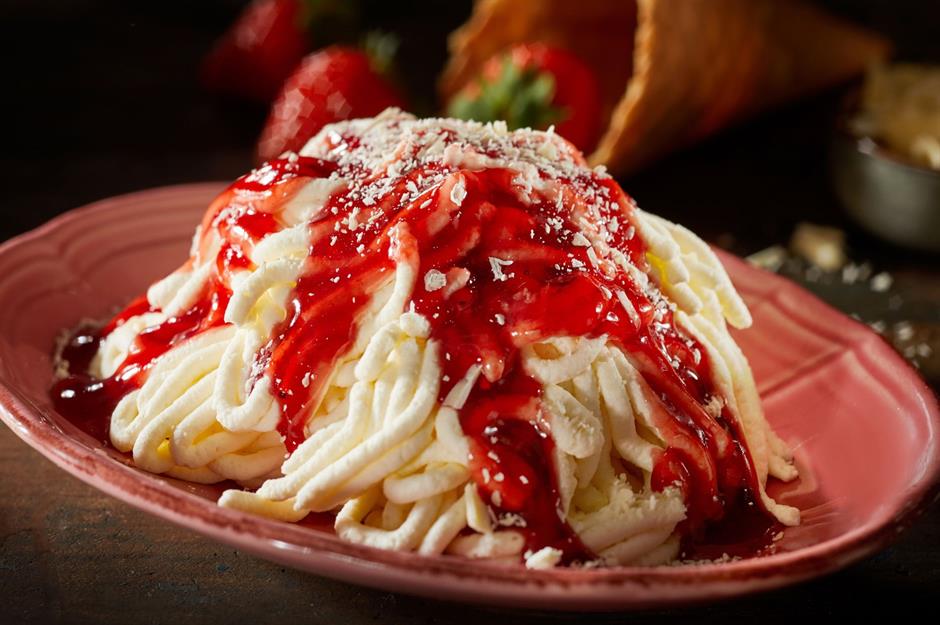
At first glance, this appears to be a pretty regular plate of spaghetti and tomato sauce. But on closer inspection, it doesn’t look quite right, does it? This uncanny dish is spaghettieis, a novelty ice cream sundae that was invented in 1960s Germany (and is happily enjoying something of a revival, thanks to social media). To make it, vanilla ice cream is pushed through a spätzle press or potato ricer, giving it the appearance of spaghetti. It's then topped with strawberry sauce and white chocolate shavings to resemble tomato sauce and shaved Parmesan.
15. Rundown and bammies, Jamaica
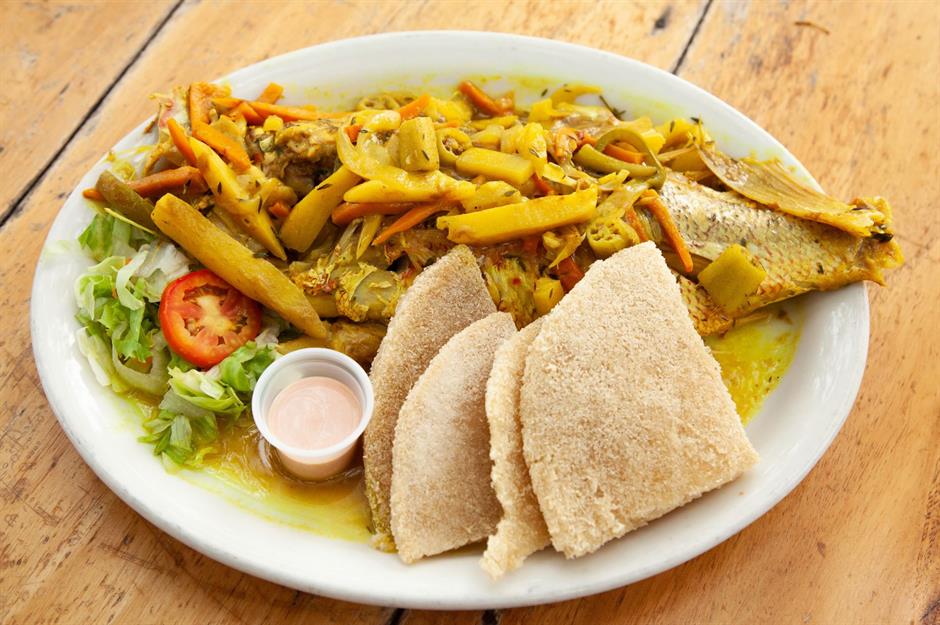
Sometimes you hear the name of a dish, and you just have to try it, whatever it may be. So, if you're ever in Jamaica, go get yourself some rundown (a creamy coconut fish and vegetable stew) and bammies (cassava flatbreads). Any type of fish can be used in the stew, but salted or pickled mackerel is the most common. The classic dish can be found in restaurants all over the island and is often eaten at breakfast alongside green bananas and festival dumplings (sweet fried dough).
14. Sabich, Israel
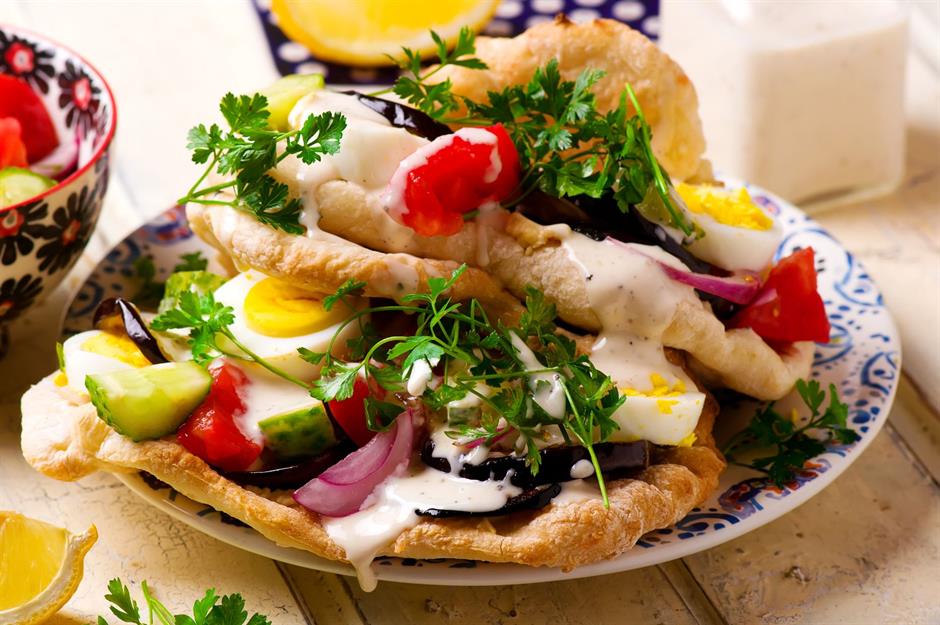
A sabich is essentially a pitta sandwich, but there’s so much more to it than that. It’s stuffed with crispy fried aubergine, slices of hard-boiled egg, hummus, tahini sauce, Israeli salad and amba (spicy mango jam), making for a wonderfully flavourful handful with amazing texture. The dish is said to have originated among the Iraqi Jews who migrated to Israel in the 1940s and 1950s, and it was traditionally eaten on Shabbat at breakfast. Nowadays, it’s an Israeli obsession, consumed throughout the day and available from restaurants and food stands all over the country.
13. Sambal stingray, Malaysia
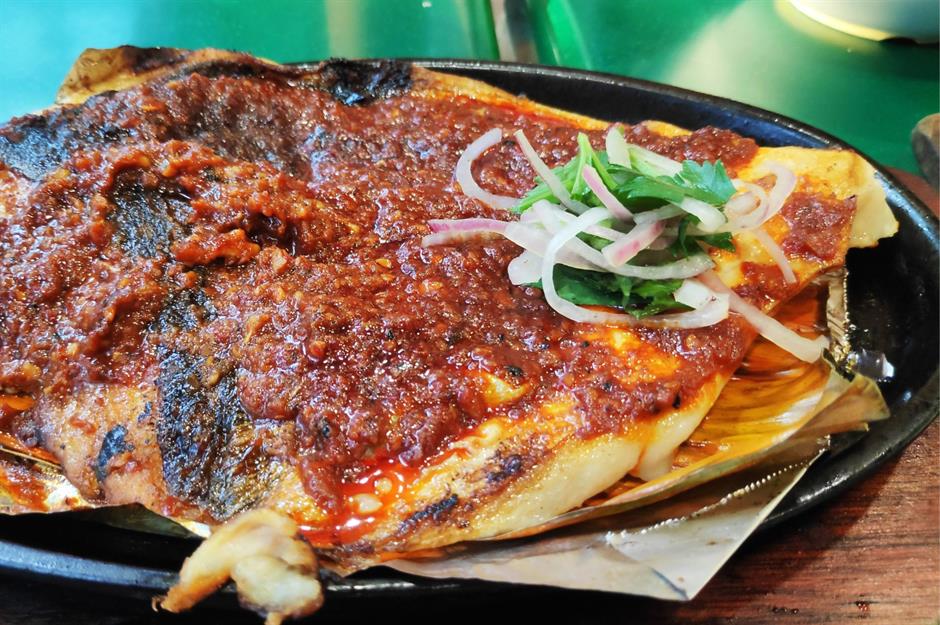
Sambal stingray (also known as ikan pari bakar) is an increasingly popular dish that's usually sold at hawker centres in both Malaysia and Singapore. It’s made by marinating big chunks of ray in a blended chilli paste, wrapping it in banana leaves, then grilling it to crispy perfection. The flesh of the fish itself is like flatfish or scallops – moist, delicate and mild – while the fiery sambal gives the dish some serious oomph.
12. Pie Floater, Australia
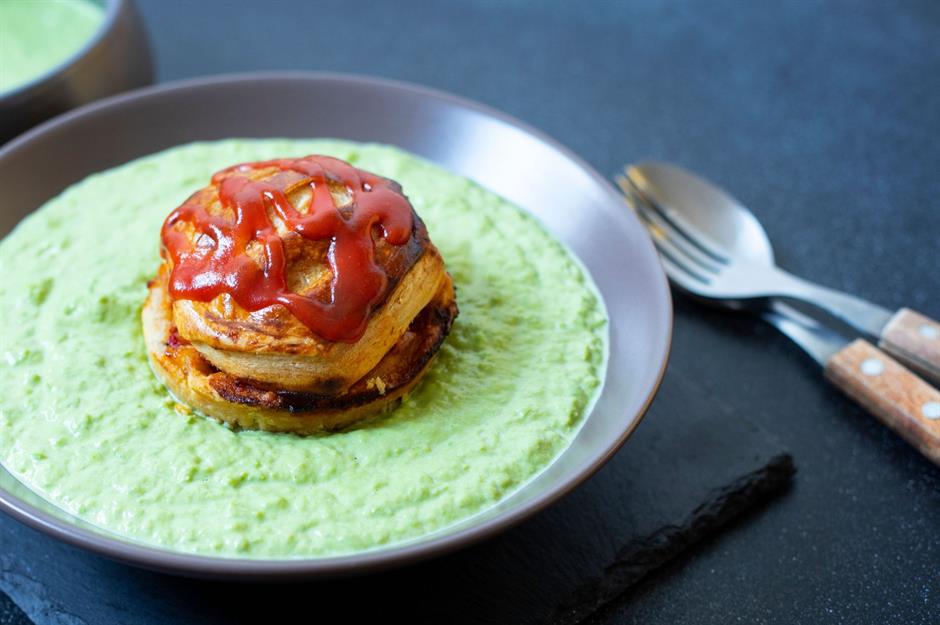
Don’t let the unusual name put you off this Australian comfort food – it’s actually incredibly tasty. Invented over 150 years ago, the dish is a speciality of Adelaide, and it's regarded as an important part of Australia’s culinary heritage. It consists of a meat pie in a thick pea soup, and it's typically served with a drizzle of tomato ketchup on top. Once sold from pie carts around the city, the hearty meat-pie-in-pea-soup meal might have English origins, but it's firmly regarded as Antipodean today.
11. Slugburger, USA
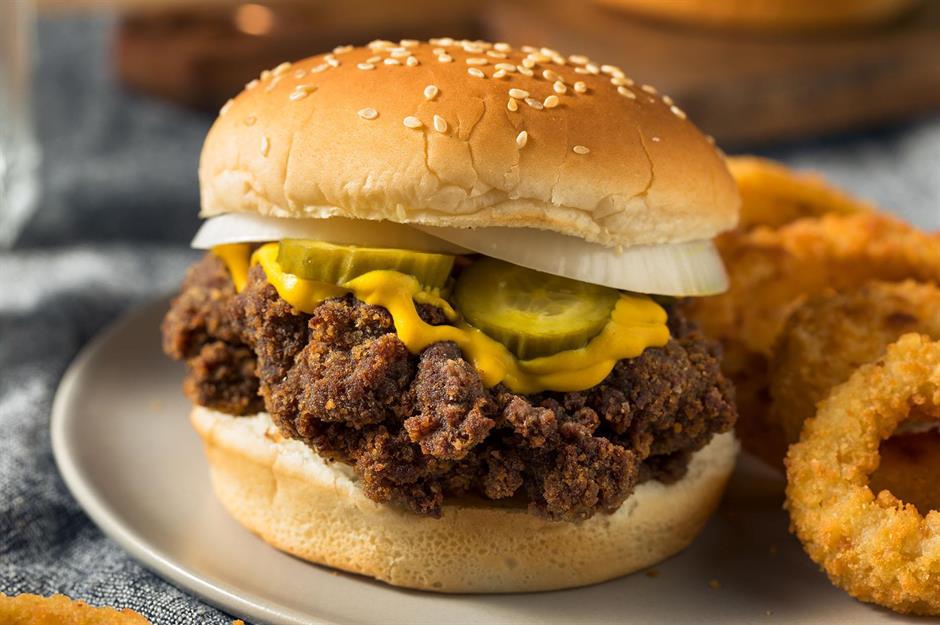
Despite the name, this Depression-era burger doesn’t contain any slugs. Slugburger patties are actually made from beef or pork mince, bulked up with an inexpensive ‘extender’ such as potato flour or soya beans, and they're served in a burger bun with plenty of pickles, onions and mustard. The Southern favourite was invented in Mississippi, and the name refers to the fact that they used to cost a nickel (back in the day, ‘slug’ was the slang term for a five-cent piece). These days, the burgers are still sold in old-timey diners, and there's even a slugburger festival in Corinth, Mississippi.
10. Chaat, India
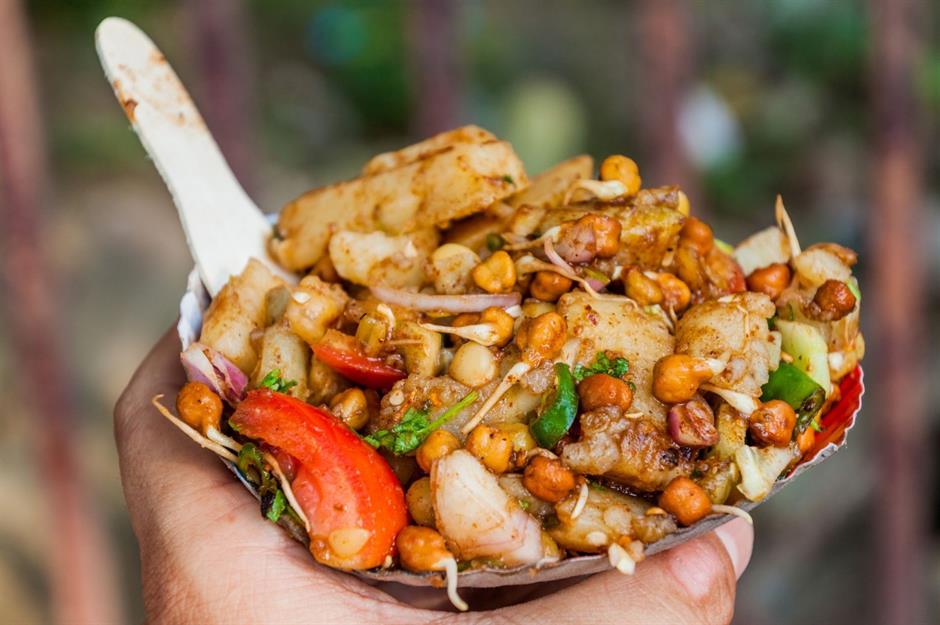
One of India’s most beloved and versatile street foods, chaat can be presented in many delicious forms. Aloo chana chaat, for example, is made from potato, chickpeas, tomatoes, onion and chutneys, and it comes topped with papdis (fried crackers), fresh coriander and yogurt. Its origins lie in Uttar Pradesh, India, but chaat has become immensely popular in the rest of South Asia too, including Pakistan, Nepal and Bangladesh. To taste some of the best chaat around, head to Delhi's famous Chandni Chowk market.
9. Injera, Ethiopia
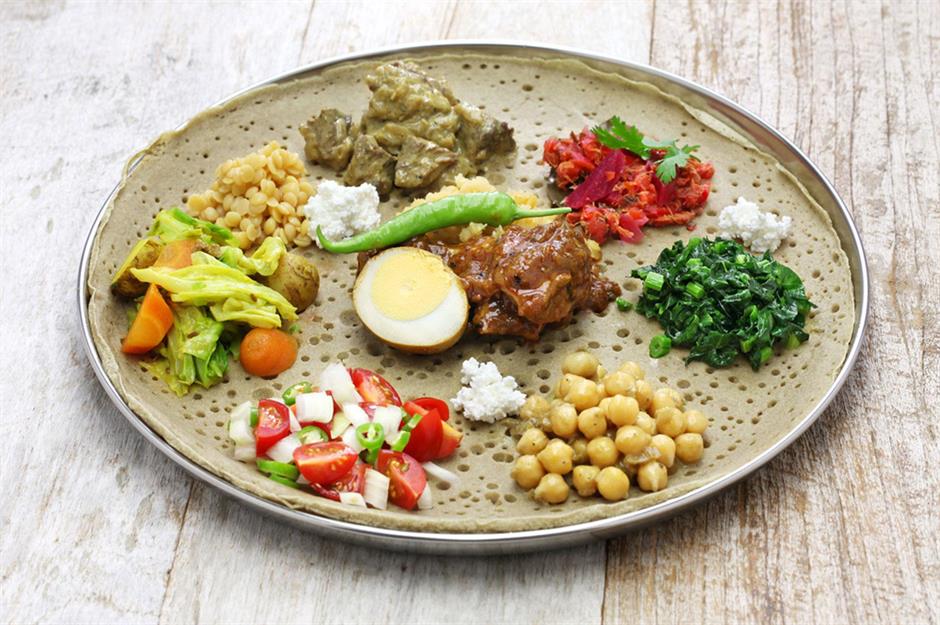
Injera is to Ethiopia and neighbouring Eritrea what baguettes are to France. In Eastern Africa, this spongy, holey pancake-shaped bread is ubiquitous, and its unique flavour is the perfect foil for spicy regional stews and meat dishes. Made from teff flour, using a process similar to sourdough, it’s gluten free and rich in iron. Ethiopian food is becoming more popular outside of the country, particularly in the UK and America, and we think injera deserves to be better known.
8. Army stew, South Korea
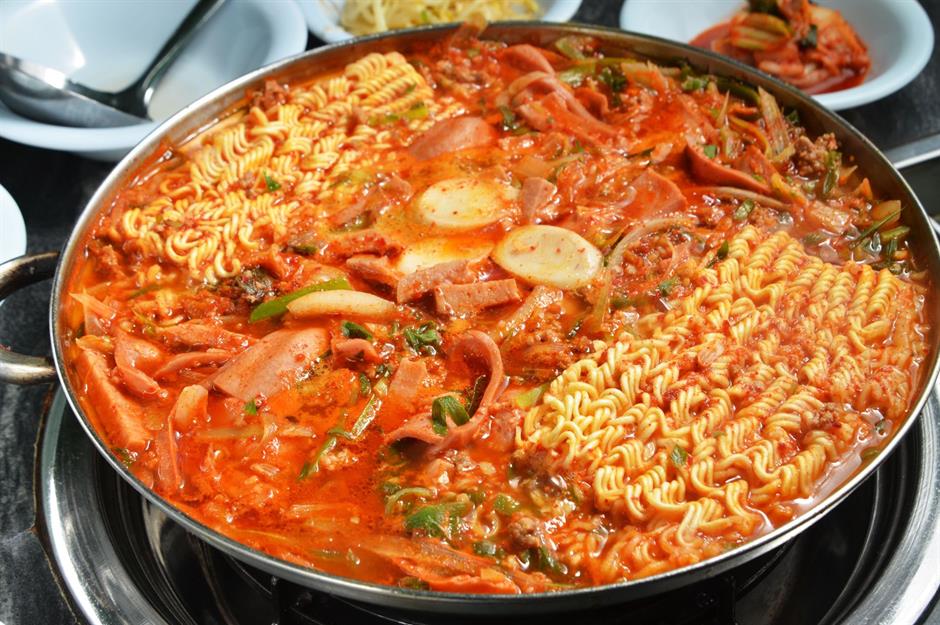
Budae jjigae, also known as army stew, is an unapologetically chaotic fusion dish that combines tinned hot dogs, SPAM, baked beans and processed cheese with noodles and kimchi to make something pretty magical. The result isn’t exactly pretty, but it’s utterly delicious. It was created around the end of the Korean War, using tinned ingredients purchased by Koreans from US army base mess halls. These days, it remains a popular comfort food, served in restaurants and home kitchens alike.
7. Egg puffs, Hong Kong

Hong Kong is a veritable culinary melting pot, with more cuisines on offer than you could ever hope to try. Street food options are numerous to the point of bewilderment, but you can never go wrong with gai daan jai: egg puffs. Also known as egg waffles, bubble waffles or puffles, they’re shaped like little eggs, and they have a crispy exterior and chewy interior. Traditionally they’re served plain, but modern interpretations see them flavoured with everything from green tea to sweet potato – and loaded with the likes of colourful sweets, ice cream and fruit.
6. Momo, Nepal
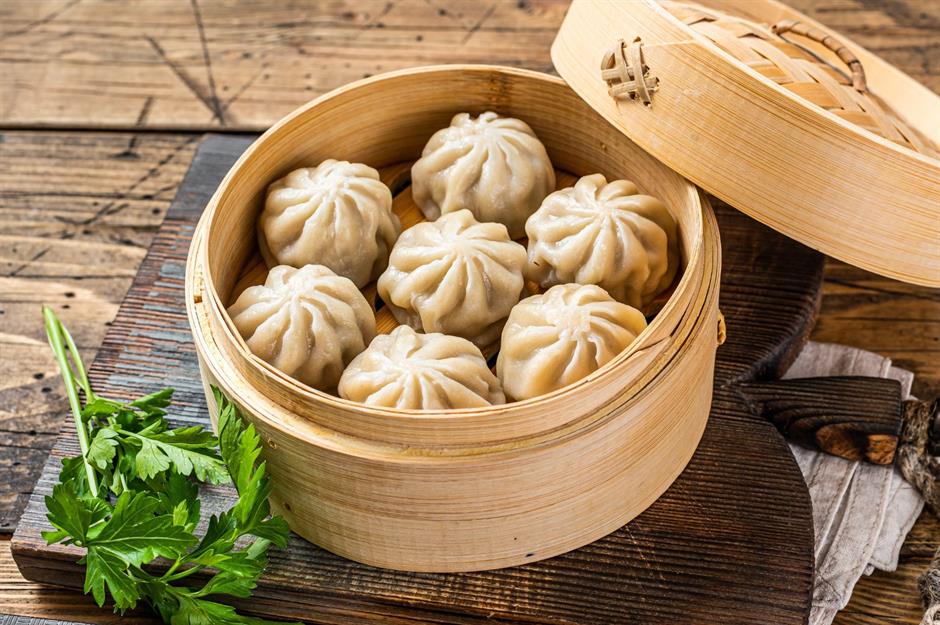
Food doesn’t get more comforting than stuffed dumplings, and Nepal’s version – momo – is among the world’s most delicious varieties, especially when served with a spicy tomato achar sauce on the side for dipping. Arguably the most popular fast food in the country, these moist and moreish parcels were traditionally filled with regional meats such as goat and buffalo; however, nowadays, the momo repertoire has expanded to include veggie and even sweet versions.
5. Obleas Colombiana, Colombia
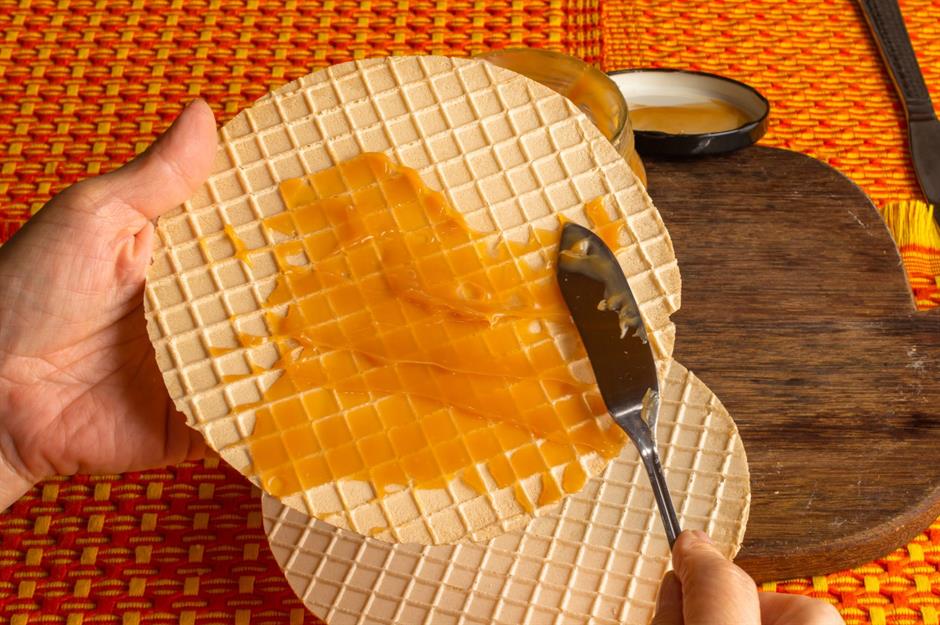
Eaten all over Latin America, but especially popular in Colombia, obleas Colombiana is basically a dream dessert. To make it, a generous smothering of Colombian-style dulce de leche (also called arequipe) is sandwiched between two giant disc-shaped wafers. The deliciousness doesn’t stop there, though – other fillings include blackberry jam, fresh fruit, shredded coconut, and a fresh, salty cheese called queso costeño, which gives the dessert an unexpected savoury kick that works brilliantly with the sweetness of the caramel.
4. Koshary, Egypt
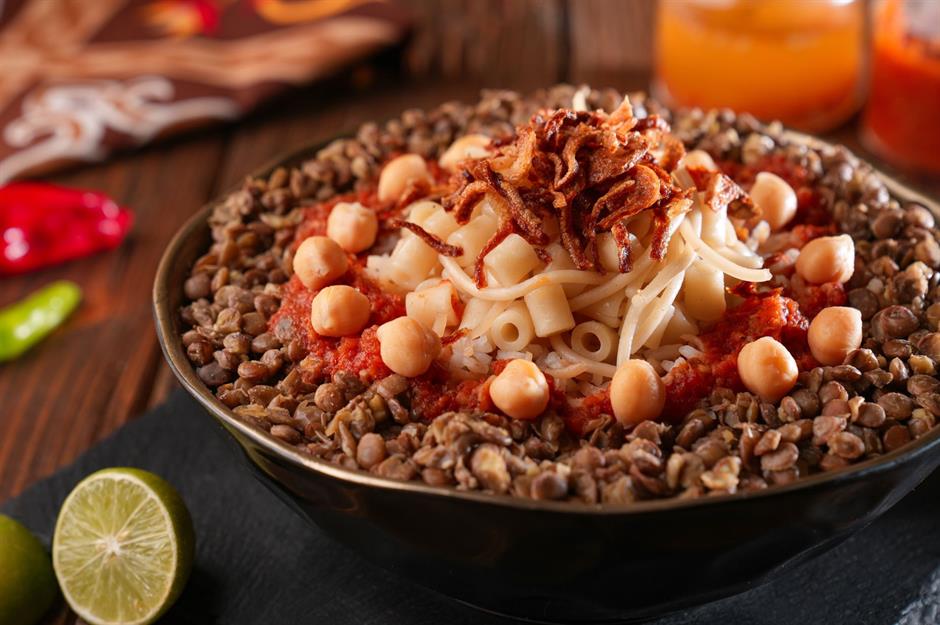
There’s such affection for koshary in Egypt that there are endless shops and stalls dedicated solely to selling the filling comfort food. This carb-laden ‘poor man’s dish’ is an addictive mishmash of lentils, macaroni and rice, topped with chickpeas, fried onions and a hot, vinegary tomato sauce made from a special spice mix. Even though it’s probably Indian in origin, it’s widely regarded as one of Egypt’s national dishes.
3. Lechon, Philippines
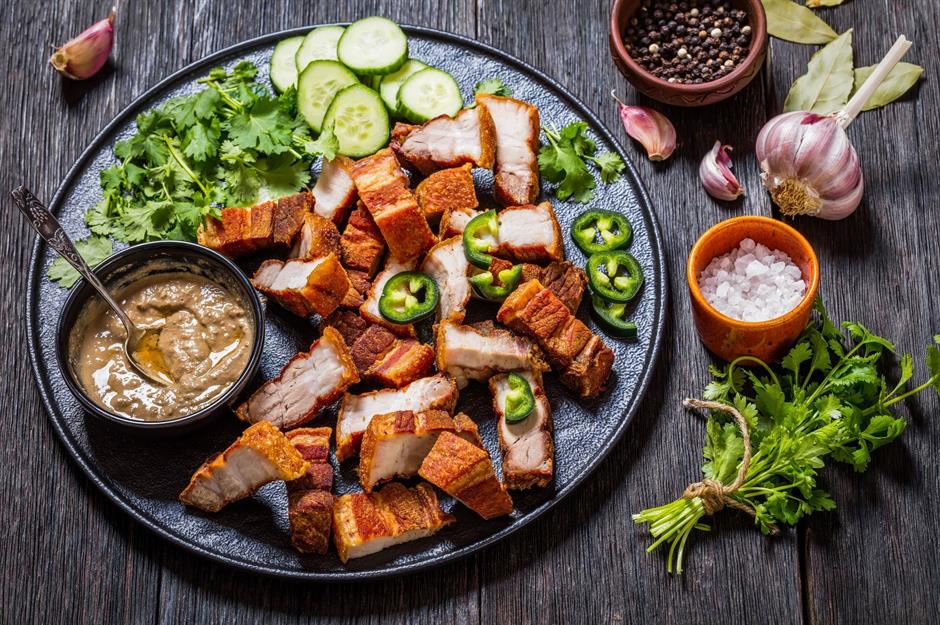
Adobo (a delicious marinated meat dish) is probably the best-known Filipino food, but lechon is the thing that gets locals the most excited. To make this celebratory dish, a whole suckling pig is slowly roasted over a charcoal pit – often rotated by hand – until the skin is perfectly crisp and golden brown. An essential accompaniment is a sweet and tangy lechon sauce, made with the pig’s liver, soy sauce, vinegar, garlic and spices.
2. Hoppers, Sri Lanka
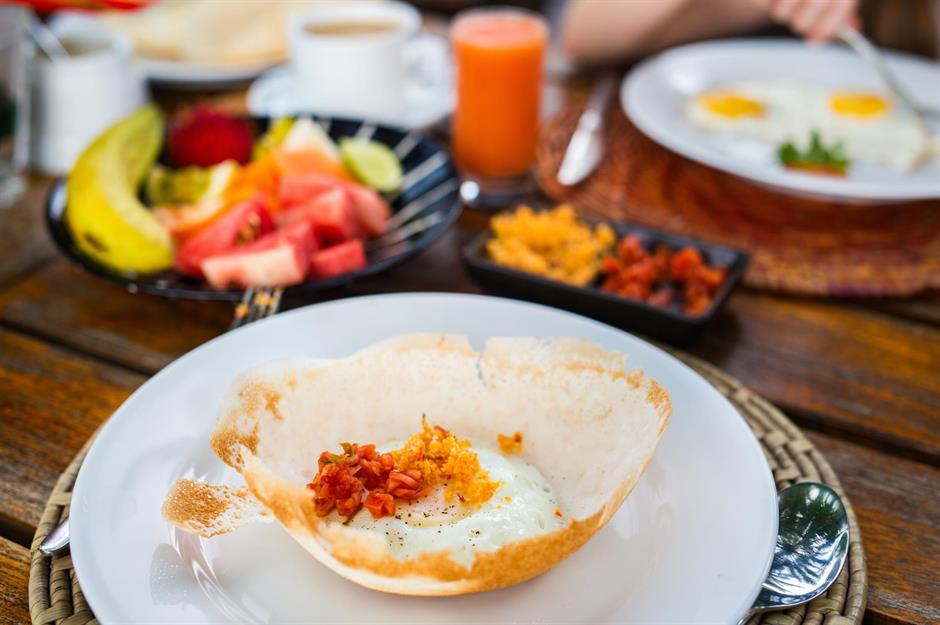
The mouthwatering egg hopper is an extremely popular way to start the day in Sri Lanka. The delicate meal consists of a fried egg cradled inside a paper-thin, crêpe-like bowl made from rice batter and coconut milk. Hoppers are usually served plain or with tasty toppings such as spicy chutney, zesty sambal or other sauces. Try an egg hopper with some coconut sambal on the side, and you’ll never want toast for brekkie again.
1. Okonomiyaki, Japan
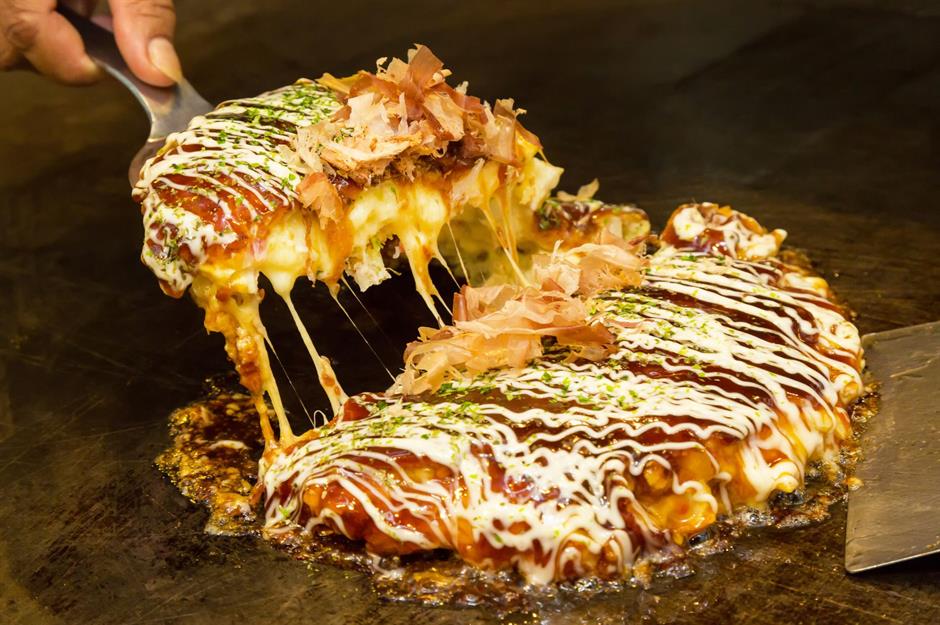
Having been usurped globally by the wonders of sushi and ramen, okonomiyaki isn't particularly well known outside of Japan – but it’s a wonderfully versatile dish that deserves celebrating. This unapologetically messy meal is sometimes referred to as a Japanese pizza, but that doesn’t really do it justice. Usually cooked in front of diners, teppanyaki style, it’s a savoury pancake loaded with cabbage, meat and seafood, and it comes topped with everything from cheese to Japanese mayonnaise and sweet and tangy okonomiyaki sauce.
Now discover the world’s most delicious dishes you’ll want to try
Last updated by Laura Ellis.
Comments
Be the first to comment
Do you want to comment on this article? You need to be signed in for this feature